The History of N-5490
By the middle of 1934 the
British Government was becoming increasingly aware of the threat of air
attacks from other European nations.
In response it announced
in July of that year that the size of the RAF would be expanded to accommodate
128 front line squadrons
within five years. At the same time the British Government began
a major personnel recruitment and training campaign.
Pre-war deliveries of Tiger
Moths from Hatfield included large batches to equip civilian-operated Elementary
and Reserve Flying Training Schools.
This was designated D.H.82A
and named Tiger Moth II by the RAF, who initially ordered 50 to Specification
T.26/33.
Others were supplied to Airports
Ltd., the Bristol Aeroplane Company, the de Havilland School of Flying,
Brooklands Aviation Ltd.,
Phillips and Powis School
of Flying, Reid and Sigrist Ltd., Airwork Ltd. and Scottish Aviation Ltd.
for the Elementary and Reserve Flying Schools
which these companies operated
under the RAF expansion scheme.
No fewer than 44 such schools
were in operation in August 1939, as well as 25 in Canada (plus four Wireless
Schools),
12 in Australia, four in
Rhodesia (plus a Flying Instructors School), seven in South Africa, and
two in India.
When war was declared, civil aviation in the UK came to an end for the duration of the war.
The outbreak of war saw civil
machines impressed for RAF communications and training duties, and larger
orders were placed.
A further 795 Tiger Moths
were built at Hatfield before the factory was turned over to de Havilland
Mosquito production,
when a Tiger Moth production
line along the lines of motor car production lines was established at the
Cowley works of Morris Motors Ltd.,
where some 3,500 Tigers
were manufactured during the war. De Havilland Aircraft of New Zealand
built a further 345 machines, and in Australia,
de Havilland Aircraft Pty.
produced a total of 1,085 Tigers. de Havilland Canada also built
a local version of the Tiger, with canopy and heater to combat
the cold conditions across
Canada. Pilot training bcame Canada's primary contribution
to the war effort.
So it was as a wartime trainer that the Tiger Moth made its greatest contribution.
History in the making.
Tiger Moth production at Hatfield before production was taken up by Morris
Motors
at Cowley, Oxford to make
way for Mosquito production.
On a rainy September day
in 1938, two Hatfield engineers attach a plumb-bob to the sternpost of
a Tiger Moth in preparation for a rigging check.
The aircraft is painted
in an early camouflage scheme showing clearly the yellow top panels, interplane
struts, fin, rudder and elevators.
The tailplane was camouflaged,
but all undersurfaces were yellow. Note the second machine with the
same colour scheme in the background.
(Edited 2.1.14 - this photograph
was more likely to have been taken over the winter of 1938, as the first
Tiger Moth with a serial starting N-6 was N-6443
which was taken on charge
at 24 MU Ternhill on 30th November 1938, and it is unlikely that the above
aircaft was the first in the series.)
Tiger Moth N-5490 (c/n 3763,
engine 80723) was built at de Havillands, Hatfield in 1938 under Air Ministry
contract 778402/38.
It was taken on charge at
24 Maintenance Unit, Ternhill, near Market Drayton, Shropshire on 17th
November 1938.
There it was prepared for
service, being fitted with various Air Ministry equipment. (To the
MU's fell the task of making regular modifications to stored aircraft,
thus keeping them up to
operational standard before issue or re-issue to operational units.)
N-5490 was allocated to
20 Elementary & Reserve Flying Training School (ERFTS), Gravesend on
10th February 1939 and taken on charge
there on 7th March 1939.
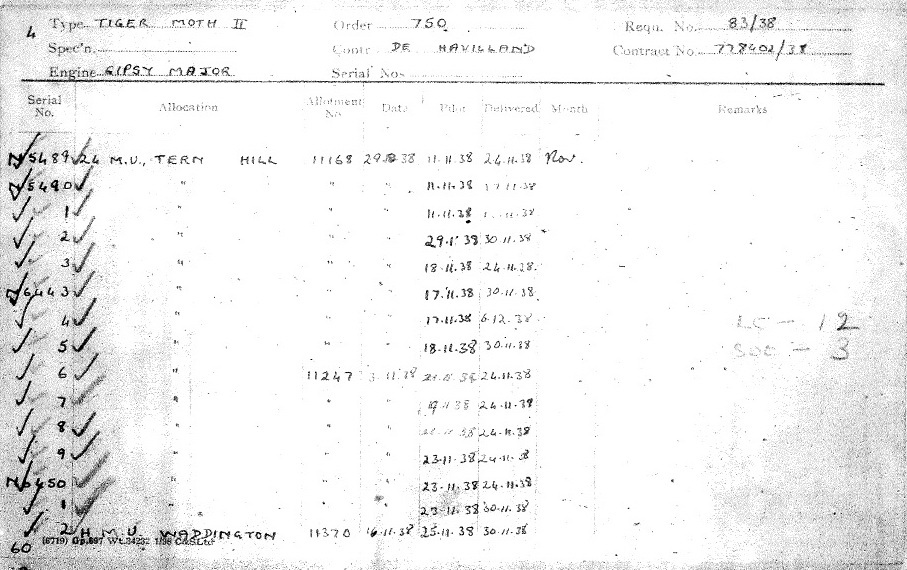
This is one of the the contract
cards for Air Ministry contract 778402/38 against requirement no. 83/38.
Under this contract,
750 Tiger Moths II's were
supplied by de Havillands to the RAF. N-5490 is the second machine
on this card.

In late September 1937 it
was arranged with the Air Ministry for Gravesend to be used as a training
school under the rearmament programme.
The establishment of No.
20 Elementary and Reserve Flying Training School by Airports Ltd. resulted
in a rapid influx of service machines to Gravesend
and the available flying
hours were fully utilised to train as many pilots as possible. Note
Hawker Hind K6655 in this photograph.
Gravesend’s landmark “Law
Hangar” was built by A & A J Law Ltd. of 132 Kingston Road, Merton
SW19. The main span was 130 feet, with a door opening of 100 feet
and door height of 20 feet.
It was demolished in early
1996 to make way for new warehousing.
20 ERFTS commenced operations
on 1st October 1937 after receiving its first three Tiger Moths the previous
day (K4254, K4283 and K4287).
Three more Tigers arrived
on the 4th October (K4248, K4251 and K4272).
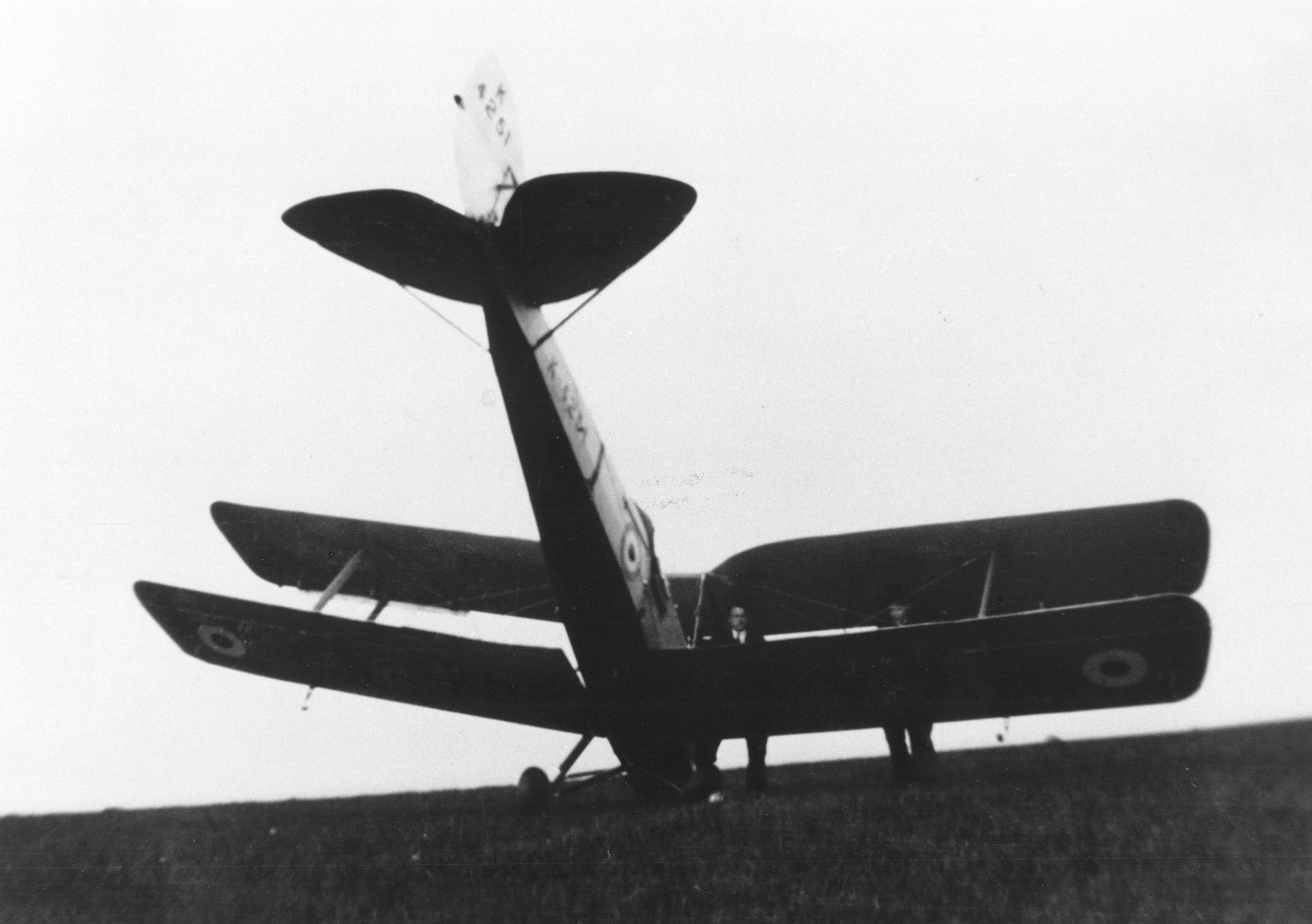
Coded '1' as the first 20
ERFTS Tiger to be coded, and in its pre Munich crisis all-silver dope scheme,
K-4251 nosed over on the airfield at Gravesend.
The aircraft was repaired
and, with the rest of the 20 ERFTS fleet, transferred to 14 EFTS,
Castle Bromwich at the outbreak of war. This venerable Tiger
started its life at RAF
Kenley in 1934 and survived the war. It was struck off charge in
1950 and sold to Hants & Sussex Aviation, Portsmouth where its wings
were burnt by them in 1960.
An unworthy fate for such a faithful warhorse.
Visible in this photogreap
are the Holt flare dispensers under the lower wings and, in the photo below,
the aileron mass balances, a feature of early Tiger Moths that were later
deleted.

Another view of K-4251 on its nose. K-4251 was delivered to 20 ERFTS on the 4th of October 1937.
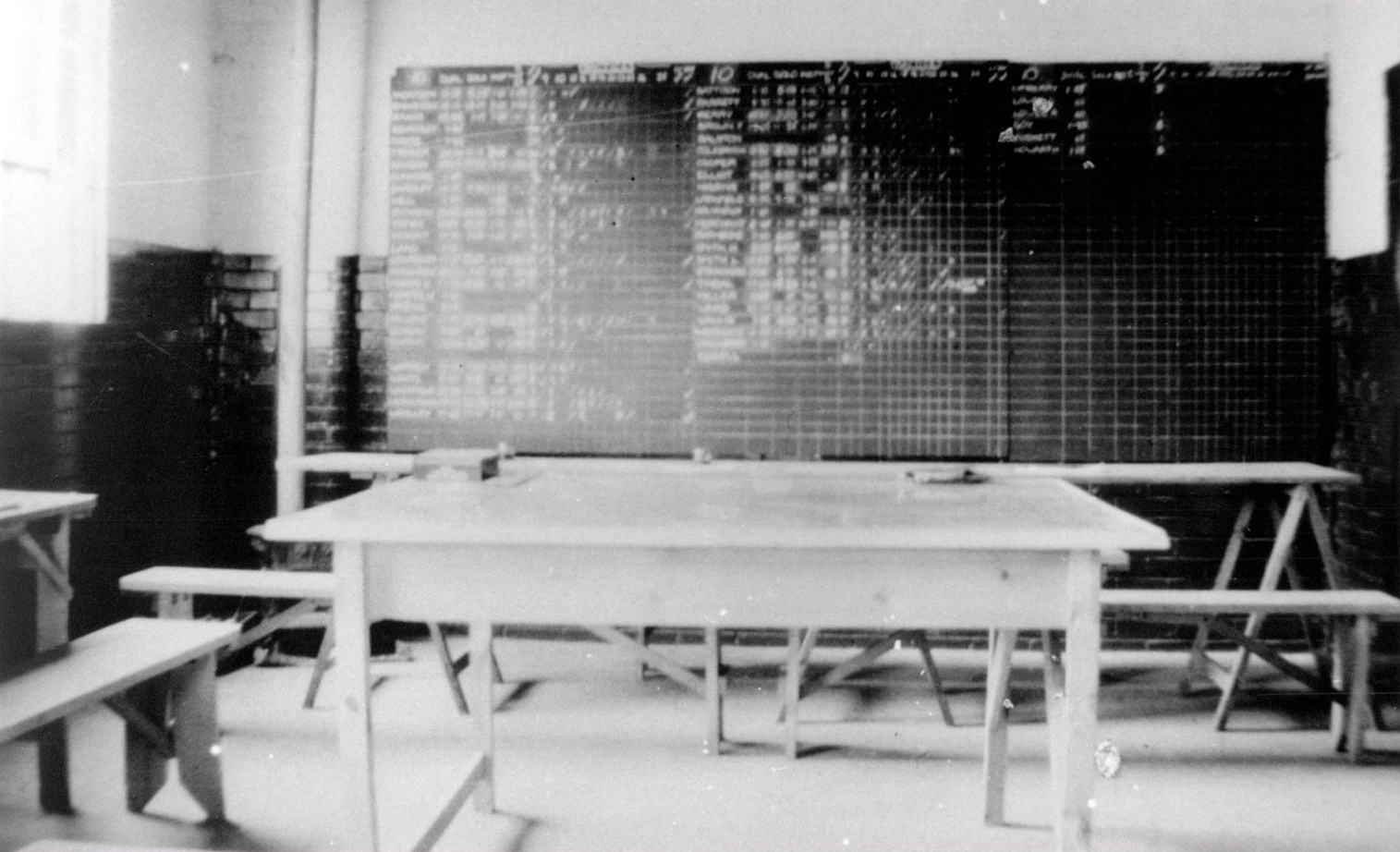
Inside the 20 ERFTS training room at Gravesend. The blackboard shows the names of 50 students and records which exercises they had completed, as well as their total dual, solo and instrument hours.

Gravesend arrodrome on 4th June 1939 showing what appears to be the 20 ERFTS Tiger Moths dispersed around the airfield perimeter.

The flight training syllabus at the time, listing the exercises shown on the board above.
In early 1939, a contract was obtained by Airports Ltd. to teach Royal Navy pupils to fly and the White Ensign was added to the airport flagpole.
From Flight Magazine, March 1939.
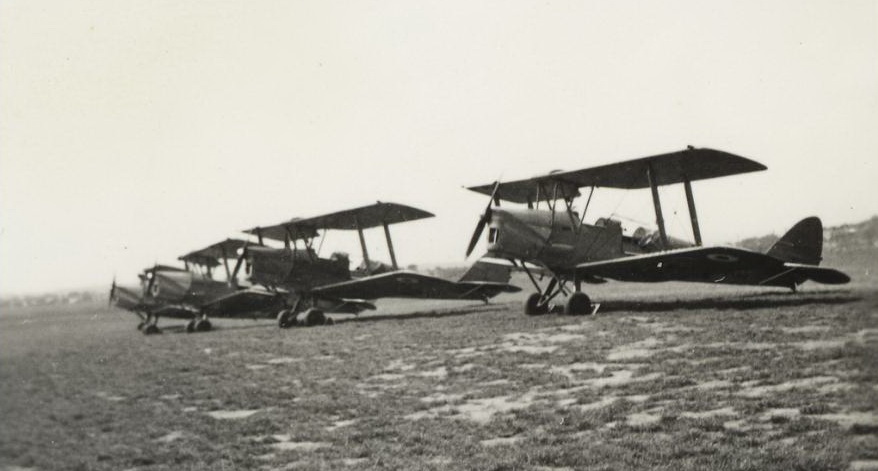
20 ERFTS Tiger Moths await
their students at Gravesend in 1939. A total of 31 Tiger Moths operated
at 20 ERFTS, Gravesend
at various times between
30th September 1937 and 3rd September 1939. Of these, five crashed
and the remaining 26 were sent
to 14 EFTS when Gravesend
was evacuated upon the declaration of war, including N-5490.
A full listing of 20 ERFTS
Tiger Moths and their fates may be found here.
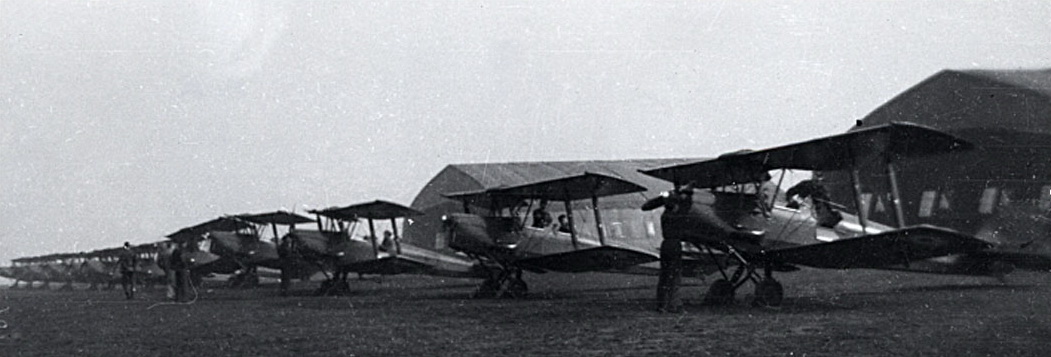
Twelve 20 ERFTS Tiger Moths
lined up at Gravesend. Note the two canvas Bessonneau hangars that
were erected to accommodate the expanding 20 ERFTS fleet.
It is not easy to see in
this image, but the third Tiger appears to be carrying the unit serial
'D' on the fuselage. If so, then this is N-5490.
K-4283 coded '3' nosed over
after a heavy landing at Gravesend. This Tiger lived to fly with
20 ERFTS again, but had an unfortunate end with 14 EFTS
when it forced landed and
hit hedge half a mile west of Ansty on 12th November 1939, and was struck
off charge four days later.

Another prang - a 20 ERFTS incident at Gravesend when a Tiger Moth collided on the ground with a Hawker Hart.
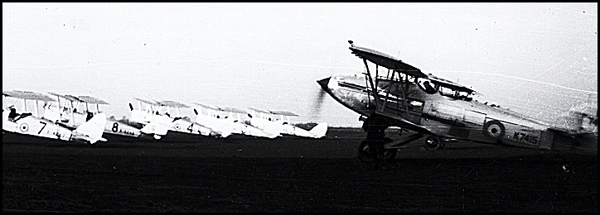
Five of the 20 ERFTS's original
7 Tigers, the nearest three coded '7', '8' and '4' at Gravesend some time
prior to April 1939. (The photograph can be thus dated because the
Hawker Hart
K7415 at right crashed into
trees during aerobatics at nearby Sevenoaks, Kent on 9th April 1939.)
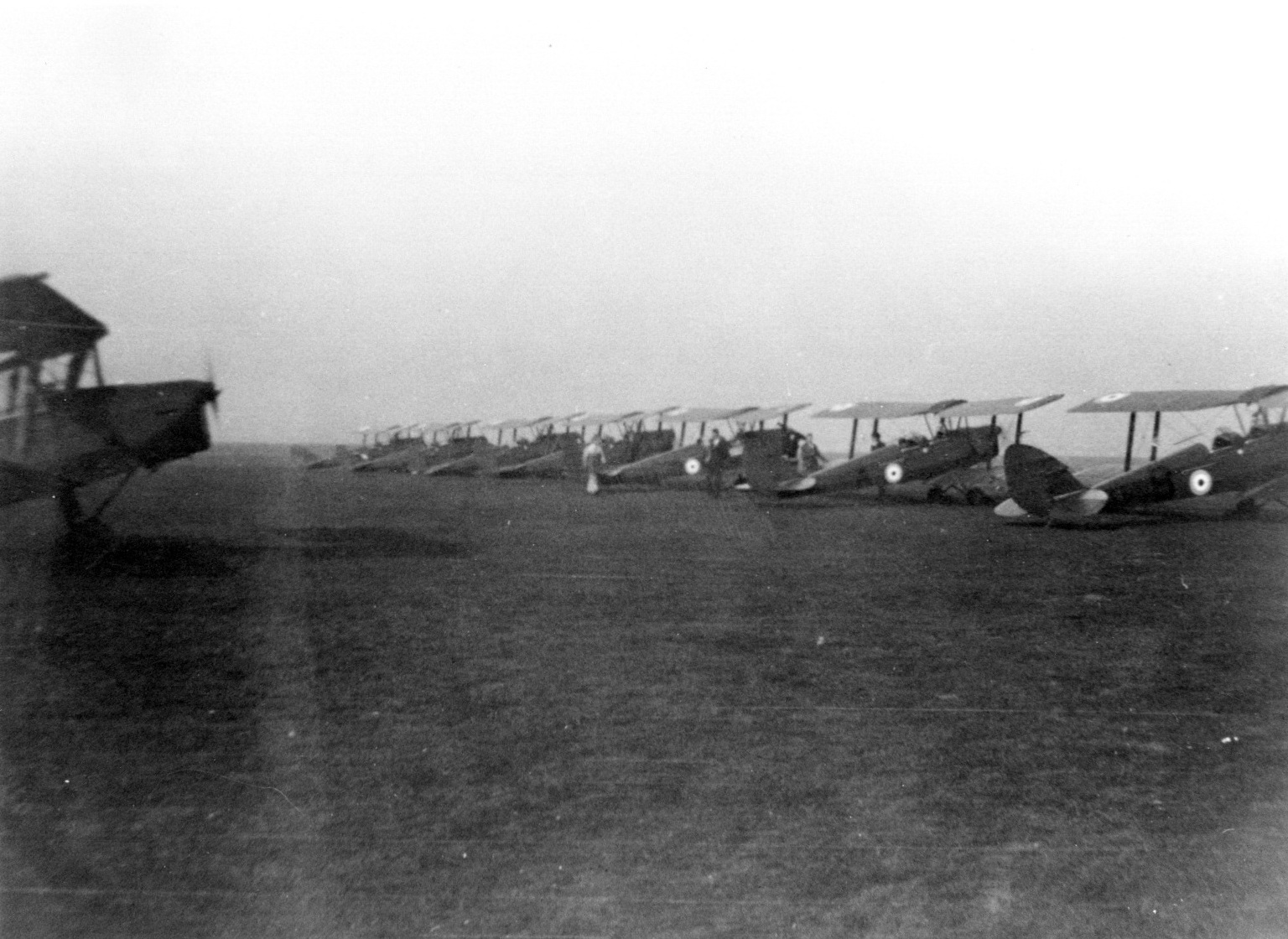
Eight of the 20 ERFTS Tiger
Moth fleet. Note the unit serial letters visible on the two nearest
Tigers on the right. Unit serial 'B' was carried by N-5493 which
was delivered to the unit on the 5th of March 1939,
two days before N-5490.
It was destroyed when it undershot and stalled at Inglestone Farm on the
second of May 1945. Unit serial 'A' was N-5483. Delivered 1st
March 1939 to 20 ERFTS. It was destroyed
while being operated by
11 EFTS when it spun into the ground at Coupar Angus, Pertshshire on the
13th of May 1941.
All of the 20 ERFTS Tiger
Moths were equipped for night flying. Note the navigation lamp on
the starboard upper wing of the Tiger Moth on the left.
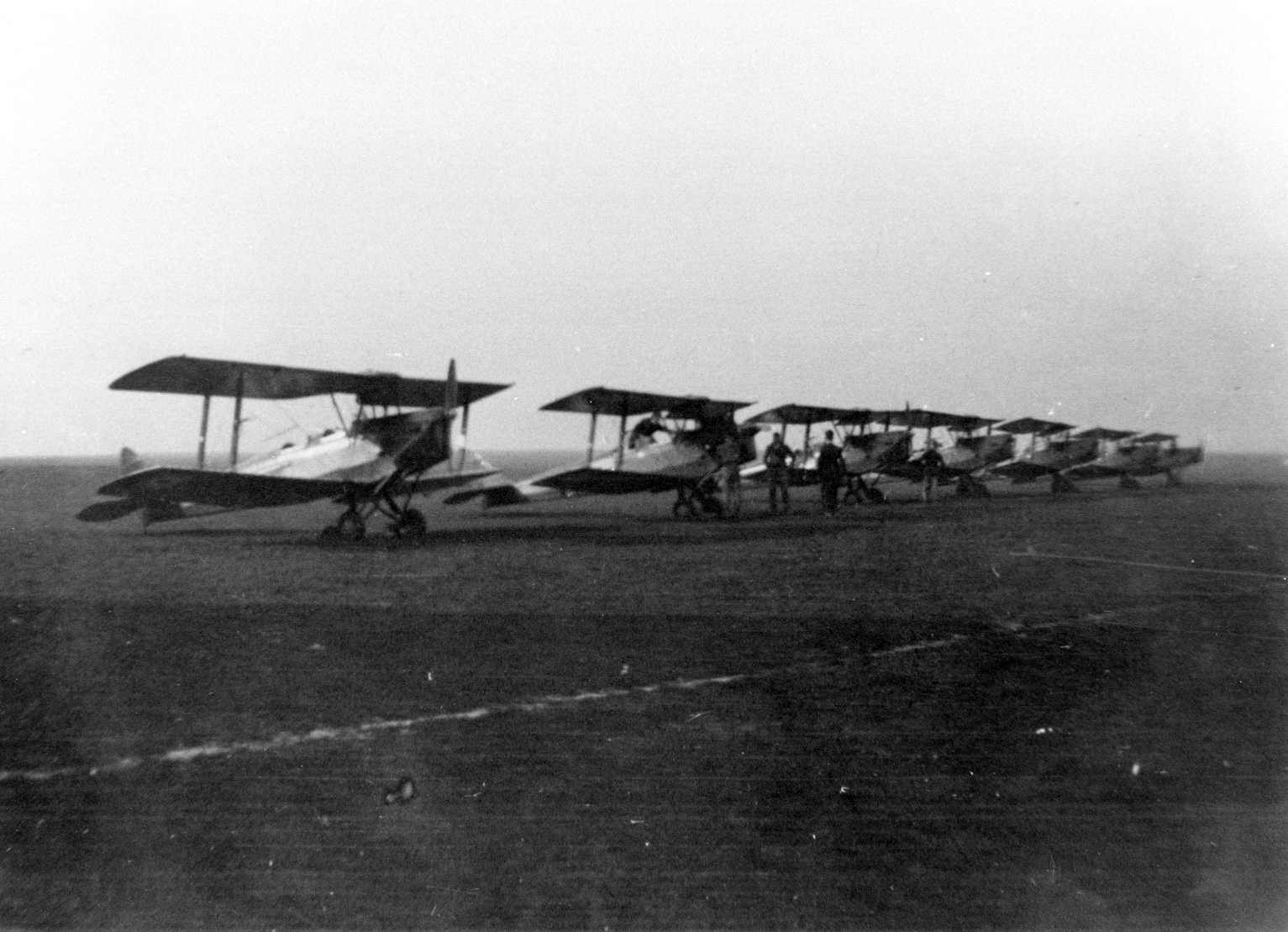
The same lineup of seven 20 ERFTS Tiger Moths from a different angle.
Another 20 ERFTS lineup. N-5491, coded 'L' is identifiable in this shot. N-5490 survived the war and was despatched to the Royal Netherlands Air Force on 27th July 1946.
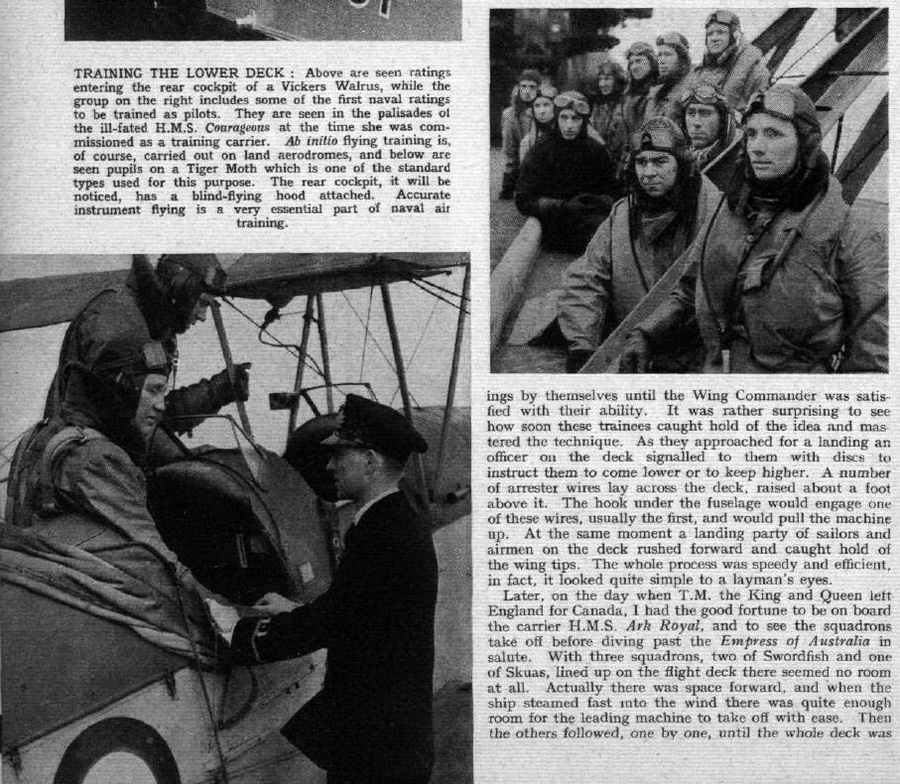
An extract from an article
in Flight magazine of 20th October 1940 which provides details of RN pilot
training.
Note the colour scheme of
the Tiger Moth at left. The demarcation line between the camouflaged
decking and the training yellow fuselage sides
is at the top fuselage longeron.
This pre-war scheme is believed to have been carried by N-5490 when it
was delivered from Hatfield in 1938.
Compare with the image at
the top of this page, and the Tigers at Elmdon in the image below.
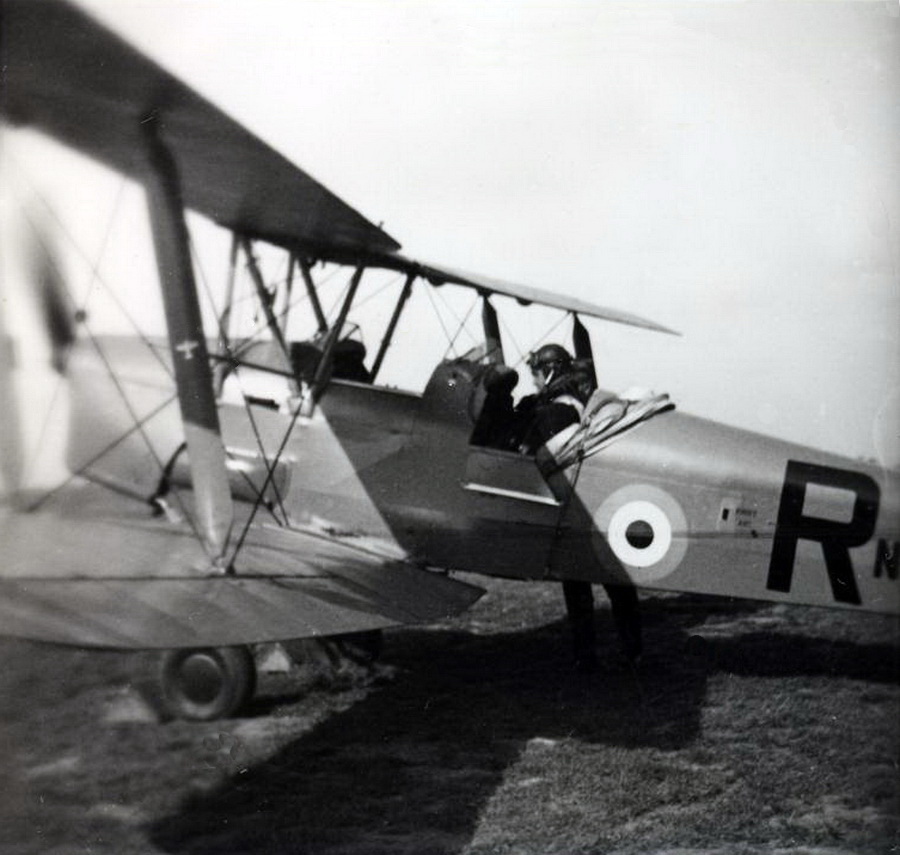
Midshipman (A) Mike Lithgow
of number 5 Air Course prepares for his first solo in N-6450, coded 'R'
at Gravesend.
His wartime flying career
was distinguished. Among other operations, Mike took part in the
Fairey Swordfish attack
on the Bismarck
which crippled the ship,
enabling HMS Dorsetshire to sink her, finally avenging the sinking of HMS
Hood.
Lithgow retired from the
Fleet Air Arm and moved to Vickers Supermarine as a test pilot in January
1946
and became the company's
chief test pilot two years later.
On 26 September 1953, flying
the Supermarine Swift F.4 prototype WK198, Lithgow broke the World Air
Speed Record
near Tripoli in Libya, reaching
a speed of 735.7 mph (1184 km/h).
Lithgow performed extensive
test flying on the Supermarine Attacker, Swift, Scimitar and later the
Vickers Vanguard and BAC 1-11.
Lithgow died test flying
the prototype BAC 1-11 G-ASHG from Wisley airfield on 22nd October 1963
when,
during stall tests, the
aircraft entered a deep stall and crashed near Chicklade, Wiltshire.
Six other BAC flight test
team members were killed.
Read his full story here.

A portent of the future.
Navy cadets of 20 ERFTS study a brand new 79 Squadron Hawker Hurricane,
visiting from nearby RAF Biggin Hill.
79 Squadron received its
Hurricanes in November 1938. Just visible in the background is 20
ERFTS Tiger Moth N-5493, unit serial 'B'.
On the outbreak of war on
September 3rd 1939, Gravesend was requisitioned by the Air Ministry and
became a satellite base for nearby RAF Biggin Hill.
20 ERFTS was quickly evacuated
to Castle Bromwich, near Birmingham. N-5490 was ferried to Castle
Bromwich on 2nd September
along with the other 25
20 ERFTS Tigers and officially allocated to 14 EFTS 15th October 1939.
14 ERFTS was established
at Castle Bromwich and operated by Airwork 1st July 1937 and became 14
EFTS on 3rd September 1939
when it was combined with
20 ERFTS and also 44 ERFTS at nearby Birmingham Elmdon, which was also
operated by Airwork.
14 EFTS continued to train
FAA pilots. However, the school left for the nearby and newly-opened
Elmdon aerodrome just six days later on 9th September
to make way for Spitfire
and Lancaster test flight operations at the Castle Bromwich Aircraft Factory
(CBAF).
This huge 'shadow factory'
was part of a larger plan to disperse production
and move vital resources
that lay within easy range of German bombers (Vickers Supermarine's original
factory at Southampton
was devastated by enemy
bombers just as Castle Bromwich came into production in 1940).
Elmdon Airport opened on
land north of the Coventry Road in 1939, but was taken over and closed
to civilian use by the RAF almost immediately.
It re-opened after the war,
and eventually became Birmingham Airport.
The 1939 Kings Cup air race was scheduled to be held at Elmdon on September 2nd.
From Flight magazine - 24th August 1939
But it was hastily canceled days before the declaration of war on 3rd September.
Tiger Moths of 14 EFTS at
Elmdon, early 1940. Note sister ship N-5454 coded '54' at right -
this was also an ex-20 ERFTS Gravesend Tiger.
(N-5454 crashed near Lichfield
on 18th June 1940, ending its days with 14 EFTS. It was repaired
but crashed again while low flying at Grange-over-Sands, Lancashire
on 17th September 1941 and
was struck off charge on the 30th September.) The Tiger (still carrying
its 20 ERFTS code 'U') is also an ex-Gravesend Tiger, N6835.
Delivered on 11th July 1939
it was, with N6836, one of the last two Tigers to be allocated to 20 ERFTS
Gravesend. (Note its later camouflage scheme, with the camouflage
now covering
most of the fuselage.
Also note the diamond-shaped gas detection patch on the rear fuselage.)
This unfortunate Tiger crashed 29th September 1940, was repaired by
de Havillands and allocated
to 257 Sqn RAF Coltishall on 11th June 1941, but its posting was short-lived.
It ended its days when it dived into the sea between Southwold
and Lowestoft on 19th June
1941, just eight days after being allocated to the unit. Czech pilot
Sgt. Vaclav Brejcha was killed in the accident.
A successful pilot, having
shot down a Do17 on the 4th February 1941 near Gt. Yarmouth, Norfolk, he
had taken part in the Battle of Britain with 43 Squadron.
He was en route from Farnborough
to Coltishall. The reason for the Tiger Moth entering a spin and
crashing into the North Sea was never established.
His body was not recovered
until the following month on the 18th July, with the funeral a few days
later on the 27th July.
See http://aircrewremembered.com/brejcha-vaclav.html.
This photo can be further
dated by study of the DH89 Rapide G-AEXO in the left background.
This aircraft was impressed as X8507 on 31st March 1940.
We see it here in its impressment
camouflage. Similarly, the DH89 in the middle background, G-AERZ,
went to Scottish Airways, Renfrew on 15th November 1940.
This this photo must therefore
date between 31st March (G-AEXO impressment) and 18th June 1940 (N-5454's
Litchfield crash).
On 26th September, N-5490
suffered a landing accident at Elmdon in the hands of Midshipman D.A.C.
Hadingham. Sent off solo by veteran Gravesend instructor
Flying Office Higgins, Haddingham
had a problem landing. He nosed over after making a wheels landing.
The Tiger bounced, and Haddingham failed to apply power
in the bounce, resulting
in the aircraft stalling, landing heavily and nosing over. The following
RAF Form 1180 has the details.


(Note. The spelling of Hadingham's name is in error on the card. His name is spelled with a single 'd'.)
Sadly, just over a year later,
Midshipman David Arthur Charles Hadingham perished while second pilot of
Whitley Mk. 5 P5091 'KN-Y' of 77 Sqn. at 0335 hrs Wednesday 9th October,
1940
while operating from Topcliffe.
Hadingham had been seconded to the Squadron for operational experience
from HMS Daedalus.
The target that night was
Hanau. The Whitley crashed into high ground half a mile west of Snape,
near Masham, Yorkshire, killing Haddingham along with
SergeantG. W. Brown, Sergeant
William G. MacMorland (RAFVR observer), Sergeant Joseph Reginald Wardman
(RAFVR wireless operator) and Sergeant Cleveland Cottham (air gunner).
The aircraft was recovering
to Topcliffe from operations on Hanau when after joining the circuit in
bad weather it flew into trees on a hillside and crashed.
Aged just 23, Hadingham
lies in Grave 4289 in the Sanderstead (All Saints) Churchyard extension,
Coulston and Purley, Surrey.
Then on 25th October 1939,
Midshipman (A) Alfred Denis Carver was flying a solo cross-country from
Elmdon in N-5490 when he became lost.
Carver made a forced landing
at Hockley Heath, Birmingham, but overshot the field, damaging the Tiger.
(Coincidentally, RAF Hockley
Heath was built in 1940 and became a satellite airfield for 14 EFTS).
Carver survived the accident,
completed his flying training. was posted to the newly-formed 829 Naval
Air Squadron on the 15th June 1940
and subsequently embarked
with the Sqn on the aircraft carrier HMS Formidable. He went on to
follow a distinguished Navy career.
Here's the RAF Form 1180 for Carver's accident:
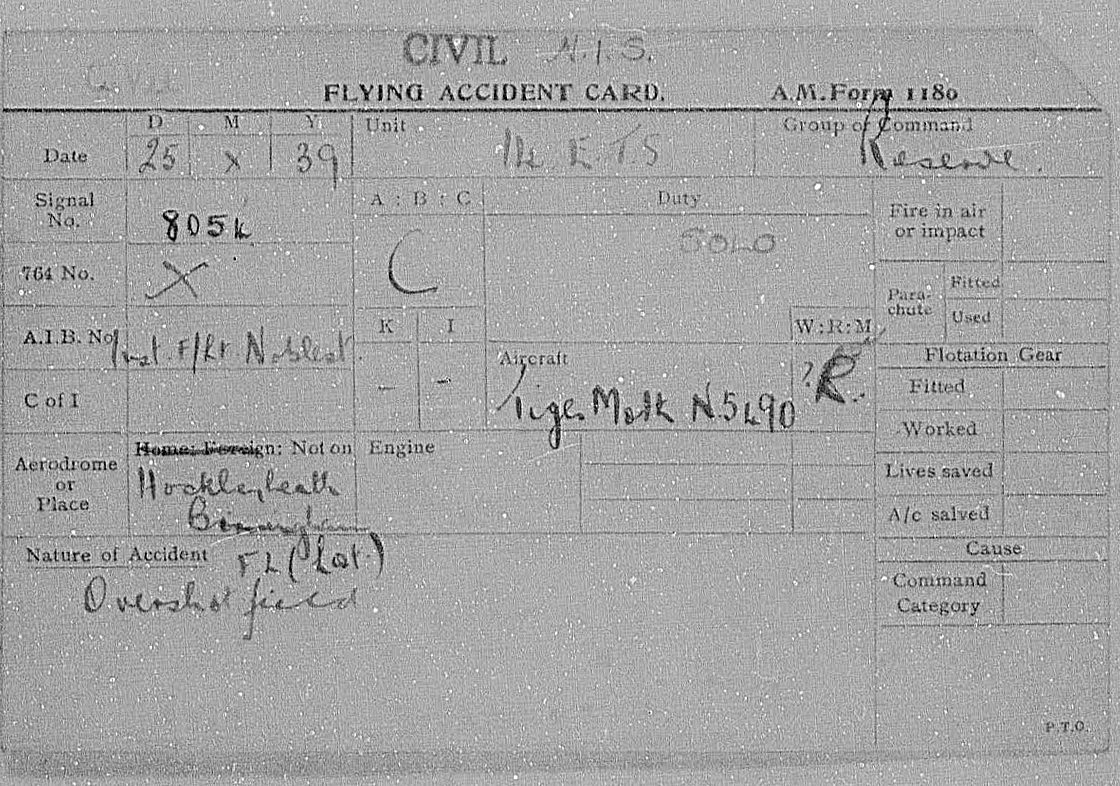

This time the damage was
sufficiently serious that the Tiger had to be sent away for repairs.
The damaged airframe was
delivered to 13 Maintenance Unit, RAF Henlow in Bedfordshire for repairs
on 1st November 1939.
No 13 MU was responsible
for repairing, modifying and assembling front line aircraft throughout
the war. During the war years, Henlow became
one of the largest RAF Maintenance
Units in the country and made an invaluable contribution to the war effort.
Women workers repairing Tiger Moths during the war
After repair, N-5490 was
ferried north to 46 MU, Speke on 19th June 1940 - the day after Churchill's
famous 'finest hour' speech to Parliament.
It was then issued to 11
EFTS, Perth (Scone), Scotland on 28th December 1940, where it spent the
rest of the war years.
In June 1936 11 ERFTS was
established at Perth in Scotland under contract to the Air Ministry by
Airwork Ltd., becoming 11 EFTS at the outbreak of war,
when there was no longer
a Reserve. The RAF took over from Airwork on 1st January 1940, and
the civilian instructors were mobilised at that time.
An emergency landing ground
was opened at nearby Whitefield to provide additional training capacity
and by the end of 1940, when N-5490 arrived,
the 11 EFTS fleet included
90 Tiger Moths. Training continued flat out during the war years,
with flying day and night - except for Thursday and Saturday nights.
In March 1945, pre-AFU (Advanced
Flying Unit) courses commenced, with the task of acclimatising Empire-trained
pilots to local conditions.
11 EFTS continued operating
after the war. In December 1945, seven Royal Danish Air Force officers
arrived for a 20-hour ab initio flying training course,
and by December 1945 there
were 135 students on the school's strength.
Perth (Scone) as photographed
by the Luftwaffe on 2nd October 1939, about 8 weeks before the arrival
of N-5490.
Note how the airfield has
been camouflaged with fake hedgrow lines. At least the photo recce
crew weren't fooled!

The airfield was just over
three miles northeast of the town of Perth and there was an emergency landing
ground at Whitefield and Relief Landing Grounds at Errol and Findo Gask.
Cross-country flights were
flown to Montrose, about 35 miles distant.
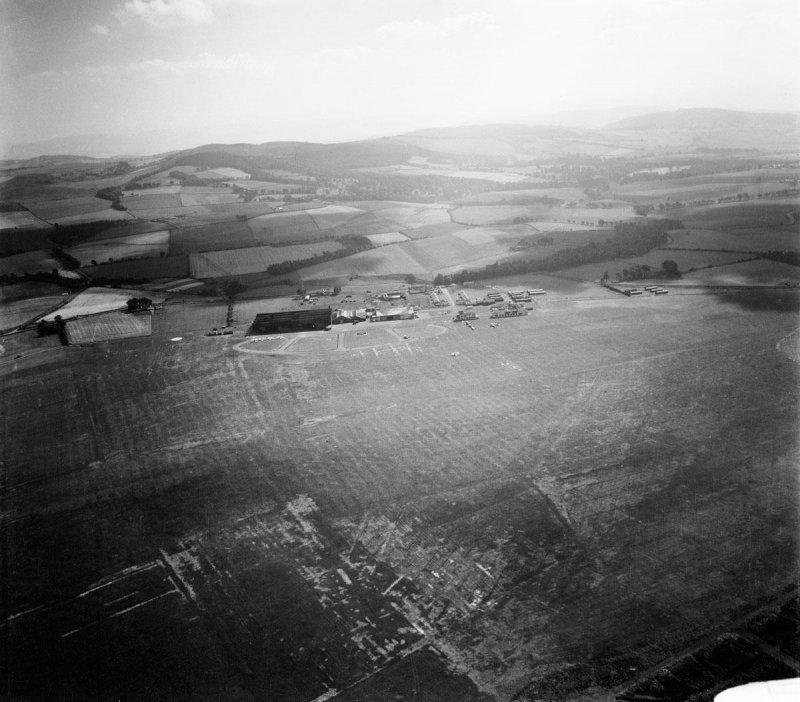
Perth aerodrome in a photo
dated 10th September 1947, shortly after N-5490 left after its wartime
service.
A number of Tiger Moths
can be seen on the airfield.
The scene at Scone aerodrome
immediately after the war, when the Tiger Moths of 11 EFTS were transitioning
from camouflage to all-over trainer yellow – unlike the hangar.
Some aircraft still carried
their unit letters on their rear fuselages and unit serial numbers on their
engine cowlings. (via M J Hooks)
Tiger Moth N-6586 was transferred
from 11 EFTS to 11 RFS on 26.6.47 and coded ‘RCR-V’.
Next to it, Tiger Moth T-7414
was transferred to 1 RFS on the same day and coded ‘RCR-D’. Therefore
this photograph was probably taken prior to that date.
N-5490 soldiered on in Scotland
throughout the rest of the war and was finally sent to 9 MU, Cosford on
16th August 1946.
(11 EFTS closed on 18th
March 1947.)
But that was not the end
of this Tiger's RAF service. On 22nd March 1948, N-5490 was re-issued
to 21 EFTS, RAF Booker near High Wycombe.
21 EFTS at RAF Booker was
mainly used for initial powered aircraft flying training for pilots of
the Glider Pilot Regiment and for refresher courses on Tigers.
Also, many Air Observation
Post (AOP) pilots of the Royal Artillery received their initial flying
training on 21 EFTS Tiger Moths at Booker.
The 21 EFTS unit codes were
FIV, FIW, FIX and FIY which N-5490 would have carried one of these.
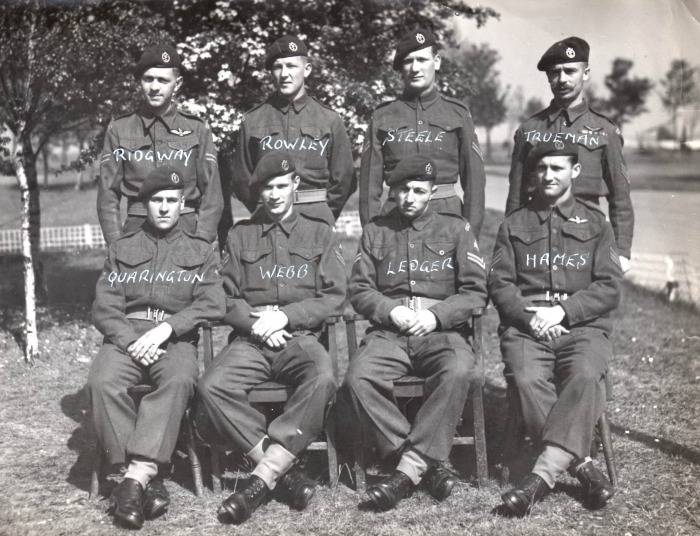
21 EFTS flying instructors at RAF Booker, believed to have been taken in the summer of 1948.
Tiger Moth DE606 of 21 EFTS,
RAF Booker, coded FIW-F. DE606 was assigned to 21 EFTS on 30th November
1943
and remained with N-5490
at Booker until the unit closed in February 1950.
These two aircraft were
to be reunited at Cottesmore in 1950 where DE606 arrived on 9th March 1950
- the day before N-5490.
A page from Sgt. Jim Hutchings'
logbook. As a trainee Army glider pilot, Hutchings was posted to
No. 8 Refresher Course, RAF Booker and flew the Tiger Moths of 21 EFTS
during 1949.
His logbook shows that he
flew N-5490 on twelve occasions between June 28th and October 17th 1949.
Hutchings' story can be
found here. Sadly,
he passed away on 24th April 2018.
(DE634 was to become well-known
after the war. It was converted by Norman Jones to 'super Tiger'
specification for the Tiger Club and named The Canon.
It spun in following release
of glider Challock on 22nd May 1969, but is currently on rebuild.)
21 EFTS closed on 28th February
1950, and so N-5490 was on the move again, being allocated to 7 FTS, RAF
Cottesmore on 10th March 1950.
Nine Tiger Moths were allocated
to 7 FTS on 10th March 1950. In addition to N-5490, they were: N9278,
T6531, T7867, DE153, DE455, DE634, DE853 and EM904.
Cottesmore at that time was
home to the Tiger Moths, Harvards, Balliols and Prentices of 7 FTS, training
both RAF and Royal Navy pilots.
The 7 FTS unit code was
FBC which N-5490 would have carried.
Less than six months later,
on 25th August 1950, N-5490 was issued to the RAF Finningley Station Flight,
along with two other Tiger Moths on the same day - EM904 and DE455,
the latter being transferred
with N-5490 from RAF Cottesmore.
On July 12th 1944, 616 (South
Yorkshire) Squadron of the Royal Auxiliary Air Force became the first Squadron
in the RAF (and that of the Allies) to become operational with jet aircraft.
They received the Gloster
Meteor Mk 1 which saw its first action on July 27th 1944 on 'anti-diver'
patrols. The Germans had started using their V1 'Vengeance' weapons
soon after the D-Day 6th
June 1944. The Squadron achieved great success claiming 10
destroyed in just 10 days. 13 was the final tally.
No. 616 squadron was officially
reformed at RAF Finningley as the South Yorkshire Squadron on 10th May
1946, with volunteers being recruited over the following few months
until embodied on 11th July
1946. It was allocated the night fighter role within Reserve Command
and the first Mosquito T.3 trainers were received in October,
but it was not until January
1948 that the operational Mosquito NF.30's were delivered to Finningley.
At the end of 1948 No. 616 was redesignated as a day fighter squadron
and began to receive Meteor
F.3's in January 1949. Conversion to the updated Meteor F.8 took
place in December 1951.
The squadron moved base
to RAF Worksop on 23rd May 1955, where it disbanded on 10th March 1957.

A Gloster Meteor F.8 of 616 Sqn. The aircraft is wearing its distinctive yellow and green Squadron insignia which was introduced in 1951, while N-5490 was attached to the Squadron.
Finally on 12th March 1952,
this war-weary Tiger was recorded as being transferred 20 MU aircraft storage
unit, Aston Down, Gloucestershire
and on 16th June 1953 was
transferred to non-effective stock, its long and arduous service life finally
over.
Notwithstanding the reference
to 20 MU Aston Down on N-5490's Movements and Contract card, it was in
fact stored with many other Tigers at 14 MU Carlisle.
These Tigers were sold at
auction by sealed tender in large batches in the early fifties, the majority
being acquired
by A J Whittemore at Croydon
for conversion and sale to the post-war civil aircraft market. Many
others went to Rollasons at Croydon.
The price paid for each Tiger was around £20, and after overhaul and refinishing in silver dope, they were sold for around £150.
This from Colin Brookes, A. J. Whittemore employee, now living in New Zealand:
"The 198 Tiger Moths Jim
Whittemore purchased in 1953 were from 'RAF MU Carlisle'. 130 were
flown down under their own power, the rest were transported by road
by my friend's father who
was a driver for by Gosling Trucking.
If N-5490 was one of Whittemore's,
regardless of what the paperwork says, they were all collected from Carlisle.
Two of my now deceased friends
were involved in collecting and flying them down. Another friend
of mine who was there at the time also confirms it,
and my friend confirmed
that his father collected the ones from there that had to come by road.
MoD records centres were
not necessarily the same place as storage of the items and often incorrect
(we are talking extremely unskilled and uninterested Post War RAF bod here).
I know this from my own
interest in ex-British Army vehicles which I have bought many from the
MOD.
The only listings I have for the ferrying pilots that Jim Whittemore used in 1952-3 are ...
Jim Whittemore
Roger Peacock
Monsieur Le Gallais
Dave Hocking
Peter Elliott
Rex Nicholls
Doug Gilbert
The following three were all connected with 'D Hangar' at Croydon:
W. A. (Bill) Webb (hangar
manager)
Private individual contractors,
Jack Fletcher and Don Horton (who were riggers and rebuilders of Tigers
and Proctors for Whittemore's)
I am fairly sure that
all will have passed away by now [2016].
The first four certainly
did many years ago. The last one I had contact with was Dave Hocking
here in New Zealand in 1968 who passed away in the early 1980's.
Jim died on the golf course
of a heart attack not long after moving the company to Biggin Hill.
Monsieur Le Gallais was killed in a crash in his Bonanza.
Incidentally, my next door
but one neighbour drove a 'Queen Mary' aircraft recovery trailer from 1941
until 1956 to Croydon Aerodrome for the RAF,
and then Field Aircraft
Services and the CAA crash authority from 1946 when it became the civilian
Croydon Airport. He often parked it outside our house and of course
all along the next three
houses during and after the war. My mother was always complaining
that it would make our house a target for the German bombers.
We were fortunate, a V1
demolished the two houses opposite ours but we survived. Croydon
was the most heavily hit area in Britain for V1 rockets (doodlebugs as
we called them).
It is recorded that they
were coming over at one time at almost 200 a week. There is an interesting
story of how British Intelligence had fooled the Germans
in to thinking that central
London was actually 10 miles further to the South ... that was unfortunately
Croydon."
Colin has recently established
a fascinating website relating to Croydon aerodrome which can be found
here.
The site contains many rare
photos of the demobbed and other Tigers that passed through Croydon in
the fifties.
Here
is the link to them, including a superb shot of F-BHIN which is N-5490
and which is reproduced below.
(Note: According to
records, Jim Whittemore bought 137 Tiger Moths at auction - not 198.
Here
is a list of them.
Colin comments: "The 198
figure was the common knowledge among the employees at the time, and currently
between the three of us still around who worked there.")
RAF Carlisle was known as
RAF Kingstown during the war. It started life as a small grass airfield
in the 1930's and was sold to the Air Ministry in 1936.
The RAF installed concrete
runways, hangars, a full range of administrative buildings and several
estates of married quarter housing for officers and other ranks.
The new station opened for
operations on 26 September 1938 as RAF Kingstown and became home to two
operational bomber squadrons flying Fairey Battle bombers with three man
crews.
With the outbreak of war
in 1939, Kingstown's runways proved too short for the latest generation
of larger multi-engined bombers and there was no room for runway expansions,
so the RAF built and developed
a new airfield at Crosby-on-Eden. The new facility came into operation
in February 1941, the station designated as RAF Crosby on Eden which,
following its wartime service,
today serves as Carlisle Lake District Airport. RAF Kingstown was
retained by the RAF and converted to No. 24 EFTS.
In 1941 RAF Kingstown was
redesignated as No 15 Flying Grading School and the station retained this
function until the end of hostilities in 1945
when the base was closed
and placed on a care and maintenance status. During the 1950's the
station was reactivated, redesignated as RAF Carlisle and retasked as No
14 Maintenance Unit,
the RAF's most northerly
storage facility in England. The original RAF Kingstown site was
established as the station headquarters and the runways
were removed with the ballast
used as foundations for a major building programme on the satellite sites
of Harker, Heathlands, Rockcliffe and Cargo where hangars,
storage buildings and administration
offices were built.
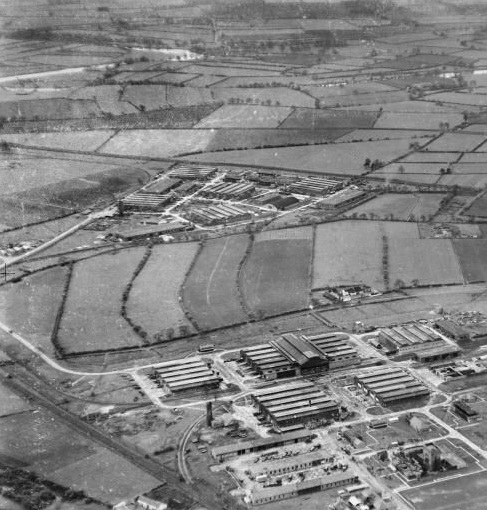
An aerial view of the sprawling
storage facilities at 14 MU Carlisle, (now the Kingmoor Park business park)
just north of the city.
14 MU is just over 100 miles
as the Tiger Moth flies from Perth, Scone. This would have been the
final flight of N-5490 in RAF service.
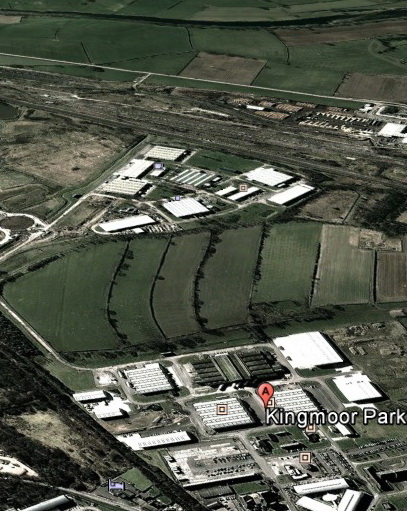
The same view today.
N-5490's Air Ministry Form 78 - Movement Card (courtesy of AHB3(RAF), MoD)
N-5490's Contract Card showing the transfer of N-5490 to non-effective stock and its subsequent sale to A .J Whitmore (sic).
The National Archives at
Kew, London hold the RAF Form 540’s (the Operational Record Books) for
wartime flying stations.
The EFTS ORB’s are held
under reference AIR 29/618. There are:
No. 11 Perth, January 1940 to March 1947
No. 14 Castle Bromwich and Elmdon, September 1939 to January 1946
These documents remain to be researched.
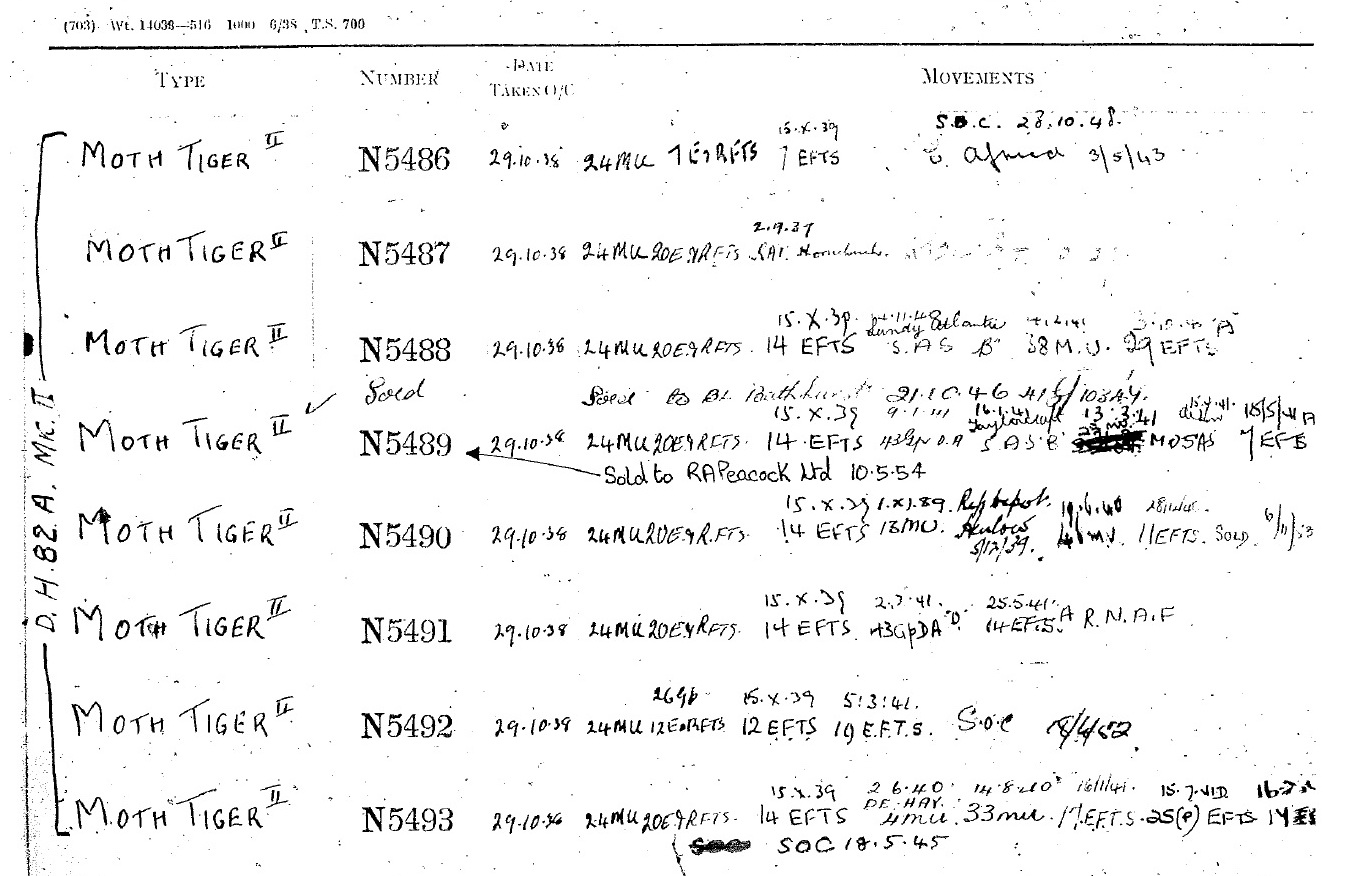
This is an extract from the
RAF's serial number ledger, showing the service lifespan of N-5490,
starting with being taken
on charge 29th October 1938 and finally being sold 6th November 1953.
N-5490's M.C.A. Form 113
N-5490 was stored until sold
by tender along with many other Tiger Moths stored at 14 MU Carlisle on
6th November 1953.
On that day, A. J. Whittemore,
Croydon, bought about 60 Tiger Moths, and followed this with a purchased
of a further 50 twelve days later!
N-5490 was registered as
G-ANHG on 4th December 1953 to A. J. Whittemore (Aeradio) Ltd., Croydon
Airport.
In the fifties, 198 surplus
Tiger Moths were acquired by A. J. Whittemore (Aeradio) Ltd., Croydon.
Many were to become the
backbone of post-war civil flying clubs. Here are just some of the
Tigers acquired by Whittemores, staked out at Croydon in 1953.
RAF markings were obliterated
and civil registration numbers crudely daubed on the aircraft with Creosote
so that they could be ferried by air from Carlisle
to Croydon. To date,
no photograph of G-ANHG in its RAF colours at Croydon has been found.
Here, sister ship G-ANJG (ex-PG671) awaits its new civil life.
(It was registered on the
24th of November 1954 as F-BGZT, and destined for the Aero Club de Picardie,
Amiens, France. It is currently airworthy in Ohio, USA.)
Along with 58 other Whittemore
Tiger Moths, N-5490 was sold on 22nd July 1955 to Continental Aircraft
Services Ltd., Croydon and the registration lapsed.
It was then registered in
France as F-BHIN and sold to France, along with a large number of Tiger
Moths
that were acquired by the
French government and passed to French flying clubs.
In the fifties, the French
government, recognising the value of light aviation, purchased considerable
numbers of Tiger Moths
and Miles Magisters at a
very low cost. These were then passed on to flying clubs.
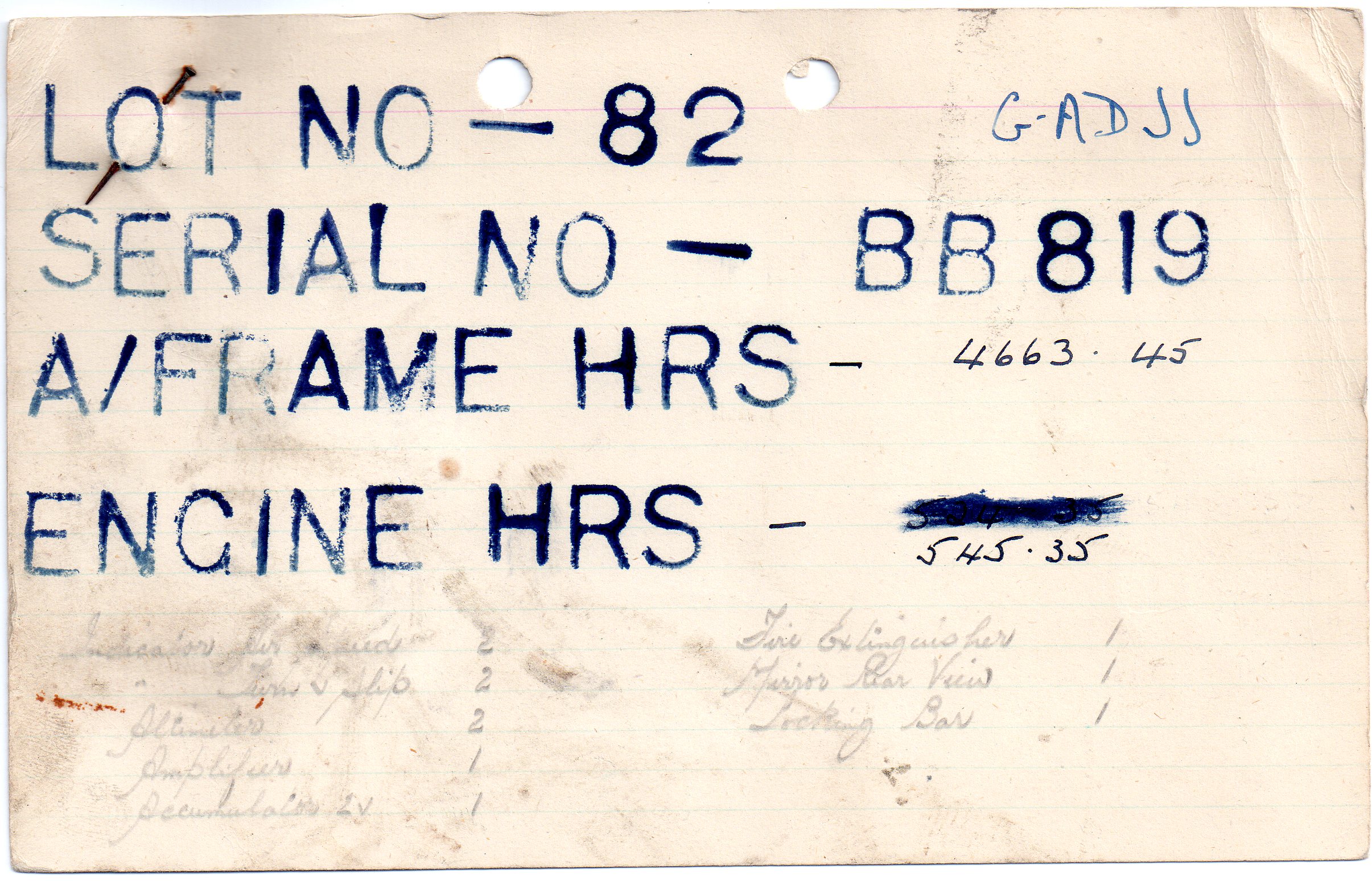
This is the demob auction
lot card for Tiger Moth BB819 - the pre-war G-ADJJ impressed in 1939.
As lot number 82, the card indicated the total airframe and engine hours,
along with ancillaries that
came with the aircraft. N-5490 would have had a similar card.

And this is the certified
extract from RAF Form 1125, certifying the aircraft fit for service.
BB819 was sold to A. J.
Whittemore on 6th November 1953 and it was re-registred G-ADJJ on 4th December
1953.
Thanks to Mark Preston for
the scans of these two historic documents.)
N-5490 in her shiny new all-over 'demob' silver dope livery and French registration marks applied by Continental Aircraft Services Ltd. at Croydon in 1955.
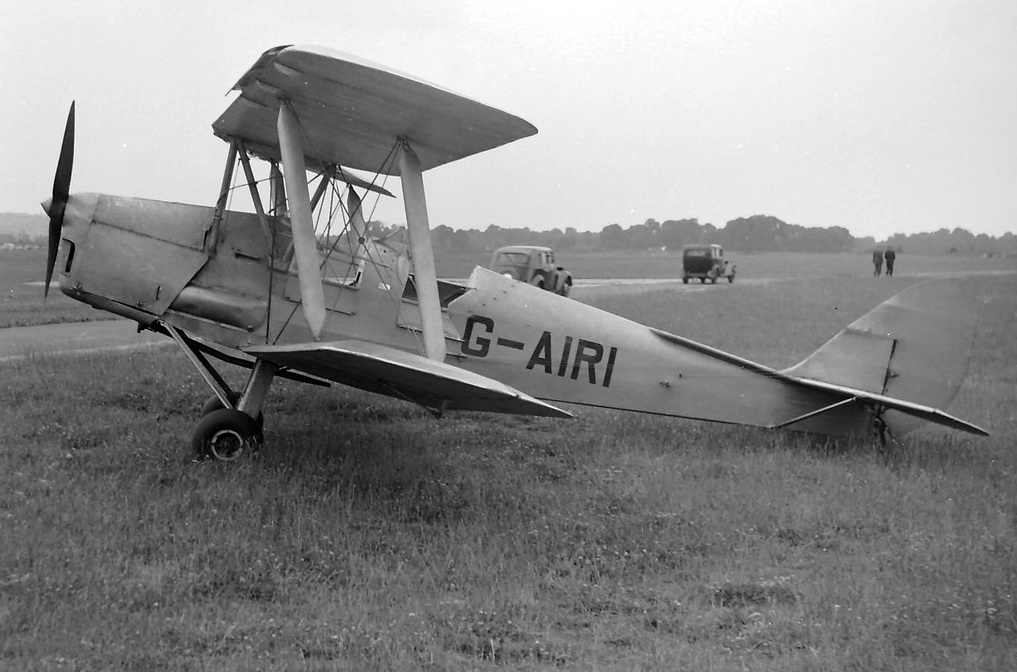
G-AIRI is the only other
known survivor of all 31 Tiger Moths that were operated by 20 ERFTS before
the War. Here it is seen on the 15th of June 1952 at White Waltham.
At some point it has had
its navigation lamps removed and a long exhaust pipe fitted, not to mention
the anti-spinning strakes which were a wartime modification.
However, still evident are
the 'Lift-the-Dot' studs that were used to secure the blind flying hood
to the rear decking. G-AIRI started life as N-5488 (c/n 3761) and
was delivered to 20 ERFTS
on the 20th February 1939.
Its unit serial was 'T'. Surviving the war, it was registered to
the West London Aero Club at White Waltham on 21st October 1946 and registered
G-AIRI the next day.
After a colourful post-war
career, including being used in the filming of 'The Blue Max', it was last
flown on the 26th of October 1981 and its C. of A. lapsed on the 9th of
November of that year.
The registration was cancelled
on the 3rd of April 1989 by the CAA. It was then stored at Little
Gransden until removed in May 2012.
Owner Anthony West is carrying
out a protracted restoration at his workshop near Bedford, but current
plans do not include restoring her to her original 20 ERFTS markings or
specification.
(Tony Clarke collection
via Dave Whitworth)

This is the French Certificate
of Airworthiness for F-BHIN, dated 25th January 1956.
To be employed in "aerobatics,
tourism and work"!
F-BHIN left Croydon on 17th
October 1955 to start a new civilian life in France. It was registered
to the Aero Club du Bearn, Pau-Idron on 27th January 1956
and became one of
several Tigers that the Club operated around this time (F-BDNZ, F-BGDL,
F-BHIC, F-BHII, F-BHIN and F-BHIQ).
The club also used their
Tiger Moths as glider tugs, and the two superbly evocative images below
show two of the club's Tigers carrying out tugging duties in the fifties.
Grateful thanks go to Jean-Marc
Lacoste of Versailles in France for the two fantastic images, reproduced
below.
Jean-Marc rescued the original
prints from the trash at Pau when the airfield closed in 1978!
Getting off while Piper J3 Cub F-BDUV taxies in.
And the point of release
as the Tiger dives away to starboard over Pau with the Pyrenees in the
background to the south.
Close analysis of the registration
on the starboard upper wing suggests that this is F-BHIQ.
G-ANHG's new life at Pau was shortlived. Her CAA C of A was suspended on the 9th May 1957 and the registration was cancelled in late 1959.
The DGAC registration details
for F-BHIN, showing it as being registered 27/1/1956 to the Aero Club du
Bearn at Pau-Idron
and 'vendu a l'etranger'
(literally sold to a stanger!) 3/5/1973.
By the seventies, almost every French flying club harboured a Tiger Moth, mostly redundant since the revision of subsidy schemes paid by the French government.
F-BHIN was stored at Pau-Idron for many years until it was recorded as sold abroad on 3rd May 1973.
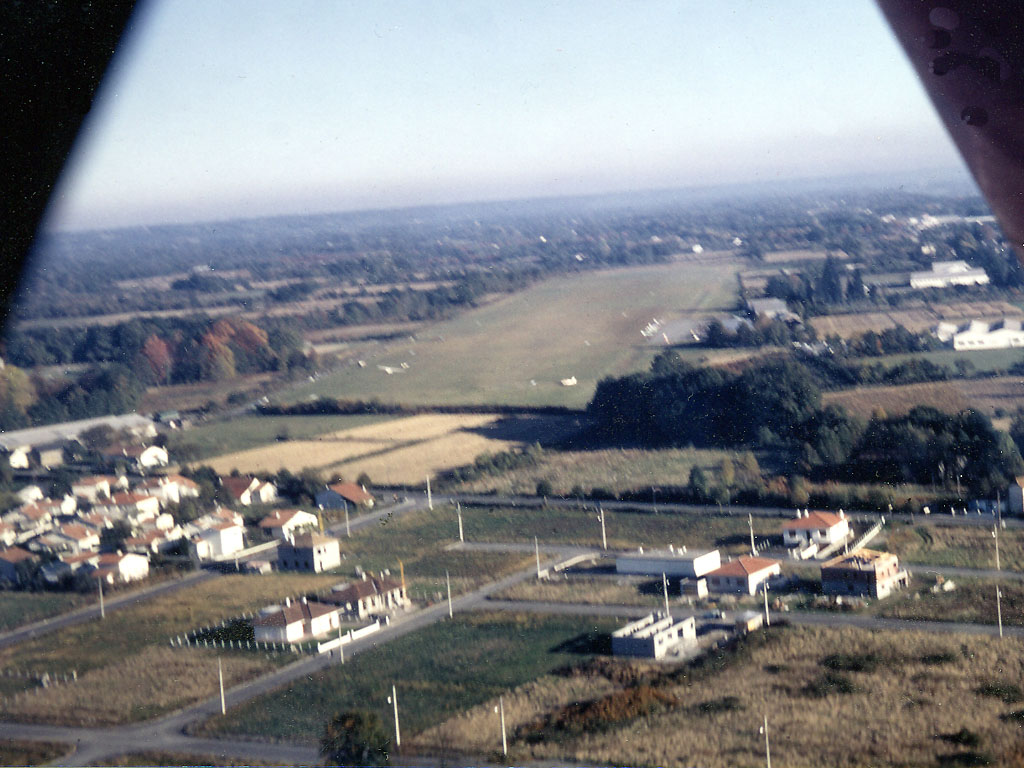
The sleepy grass airfield
at Pau-Idron, just north of the Pyrenees as it was in 1967 (it is now an
international airport!). Somewhere in the hangars on the right is
F-BHIN.
(Pau Idron's claim to fame
is that the first flying school in the world was founded here in 1908 by
Wilbur Wright.
In fact, it was also the
first aerodrome anywhere in the world. The Aero Club du Bearn is
the direct descendent of that flying school.)
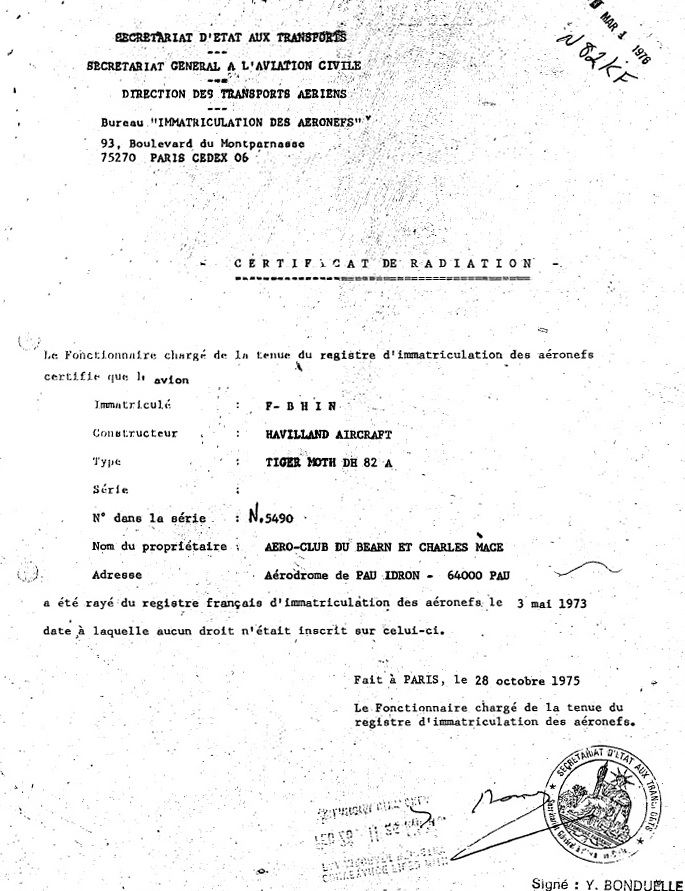
This is the certificate of de-registration of F-BHIN, with effect from 3rd May 1973.
N-5490 had been acquired
by Geert Frank, a Captain with Delta Airlines, and exported to the USA.
Geert was an airline pilot
who ran a spare-time business importing Tiger Moths and other vintage aircraft
from Europe.
He established a restoration
shop at Plum Island, a barrier island on the northeast coast of Massachusetts.
Geert had written a letter,
translated into French, and sent a copy to all known owners of French registered
Tiger Moths,
together with the convenience
of a suitably stamped and self-addressed envelope.
The message was fairly stark:
Do you have a Tiger Moth? Will you sell it to me? How many
francs do you want?
It was soon clear from the
polite replies that a lot of Tiger Moths already had been sold.
A letter from Geert Frank
that was published in 'Paper Tiger', issue 46-20 in 1999. Paper Tiger
was the newsletter of the US Moth Club.
Note that Geert imported
a total of 123 Tiger Moths from Europe into the USA, including N-5490.
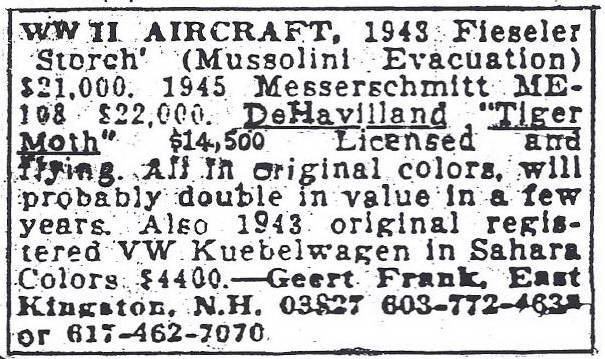
An advertisement placed by Geert Frank in the New York Times, 1974.
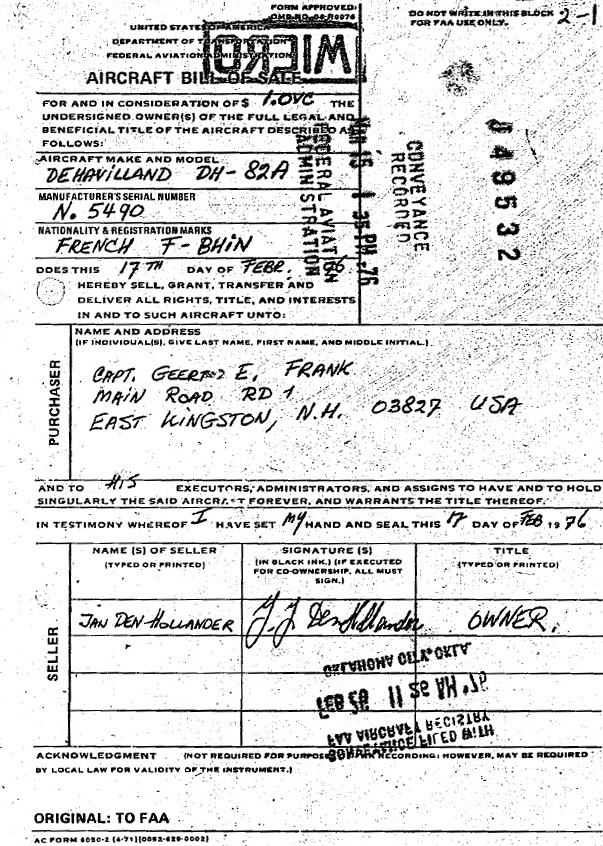
This is the Bill of Sale for F-BHIN, dated 17th February 1976, to Captain Geert Frank, the owner being stated as Jen Den Hollander.
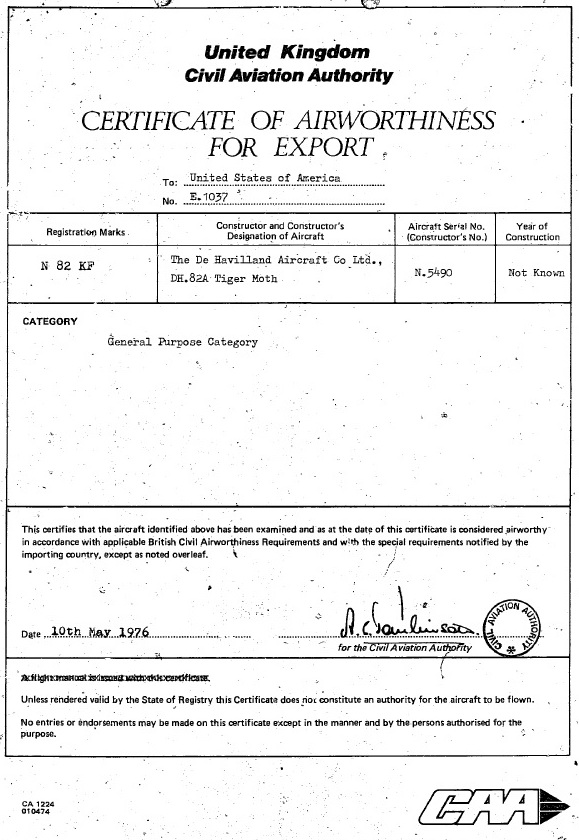
This is the UK CAA's Certificate of Airworthiness for Export, dated 10th May 1976.

This is the application for FAA registration as N82KF, dated 23rd Februaty 1976.
The initial logbook entry
for N-5490 when imported by Geert Frank, dated 3rd May 1976.
Unfortunately, previous
logs have not survived. Geert told me that he destroyed the logbooks
of the Tigers
that he imported - because
their content may have complicated US certification!
And the initial engine logbook
entry. This engine was imported in 1972 - some time before the import
of N-5490.
Geert Frank acquired this
overhauled engine from the Belgian State Flying School at Grimbergen which
trained pilots for SABENA,
and the two BTH magnetos
have been found to have SABENA overhaul tags attached. Perhaps N-5490
was imported
engineless from France,
or maybe the SABENA engine had more hours remaining.
Perhaps one day N-5490 will
be reunited with its original Gipsy powerplant - Gipsy engine #80723.
If you know the whereabouts
of this engine, please get in touch!

This is the Special Airworthiness Certificate for N82KF, dated 5th May 1976.

This is the reverse of the Special Airworthiness Certificate, authorizing test flight.
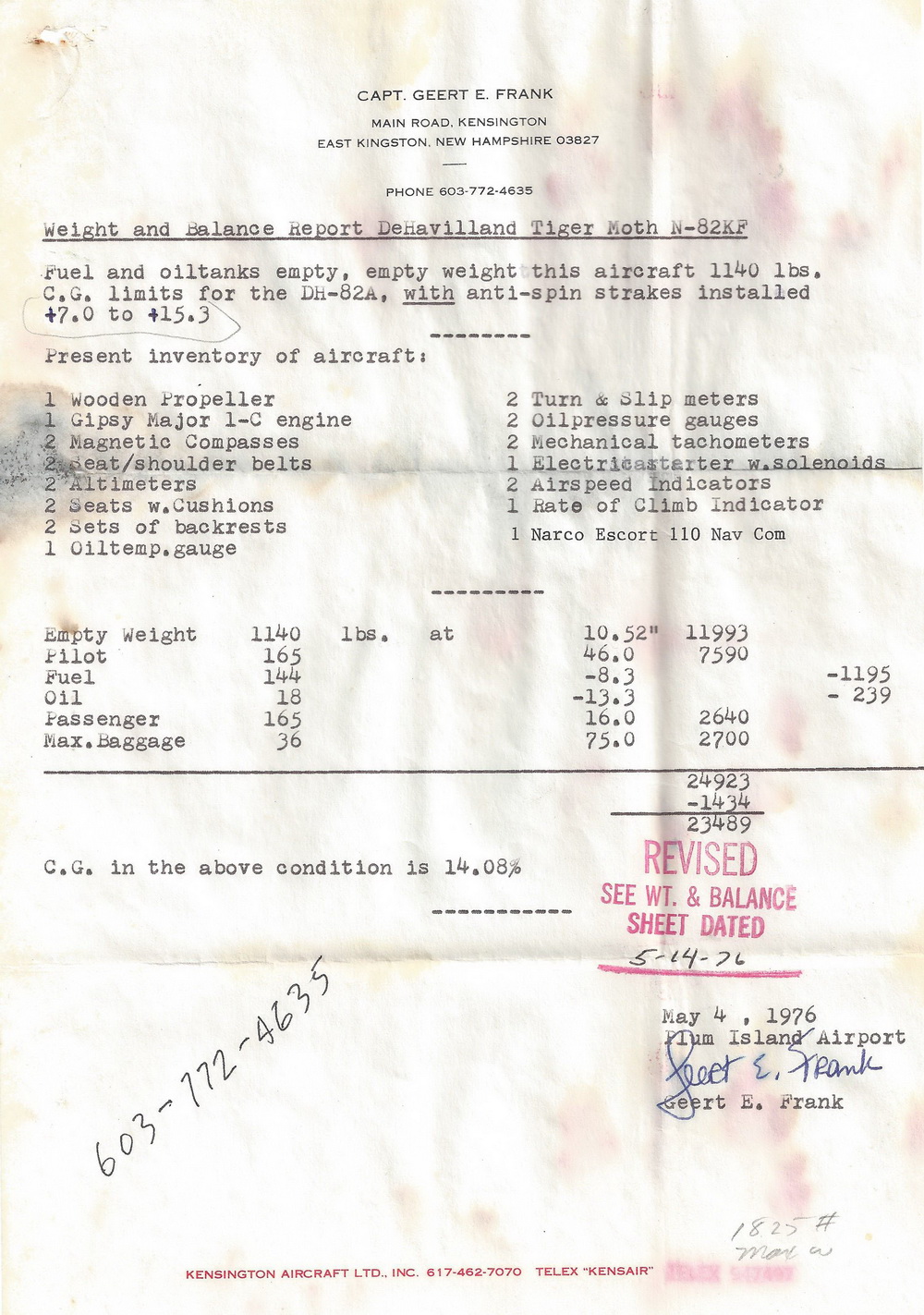
This is the weight and balance
schedule, signed by Geert Frank, at Plum Island Airport, dated 4th May
1976.
Note that the aircraft was
fitted with an electric starter and a Narco 110 radio as well as an oil
temperature gauge and a rate of climb indicator - all non-original.
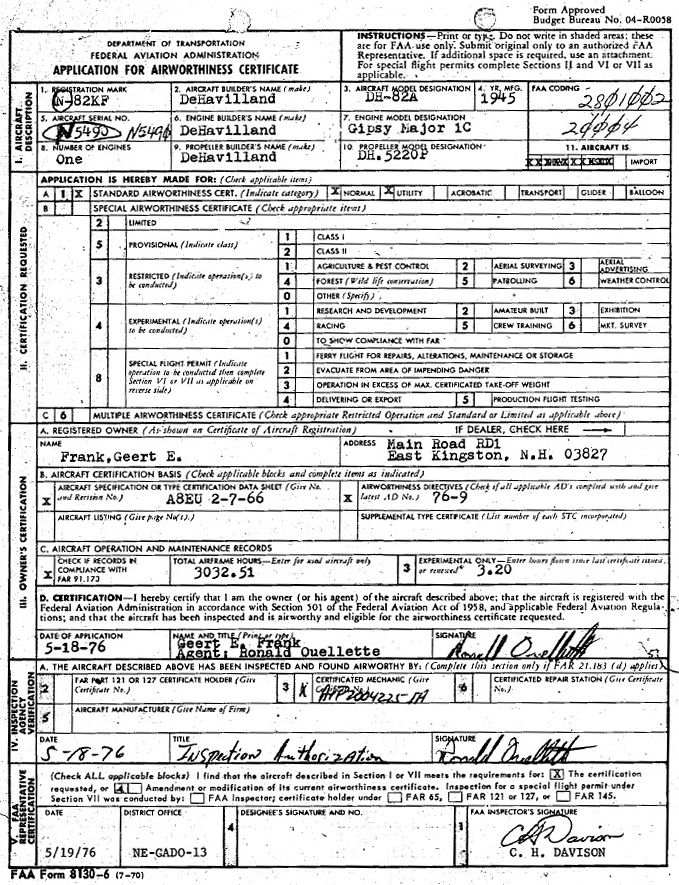
This is the application for the Certificate of Airworthiness, dated 19th May 1976.
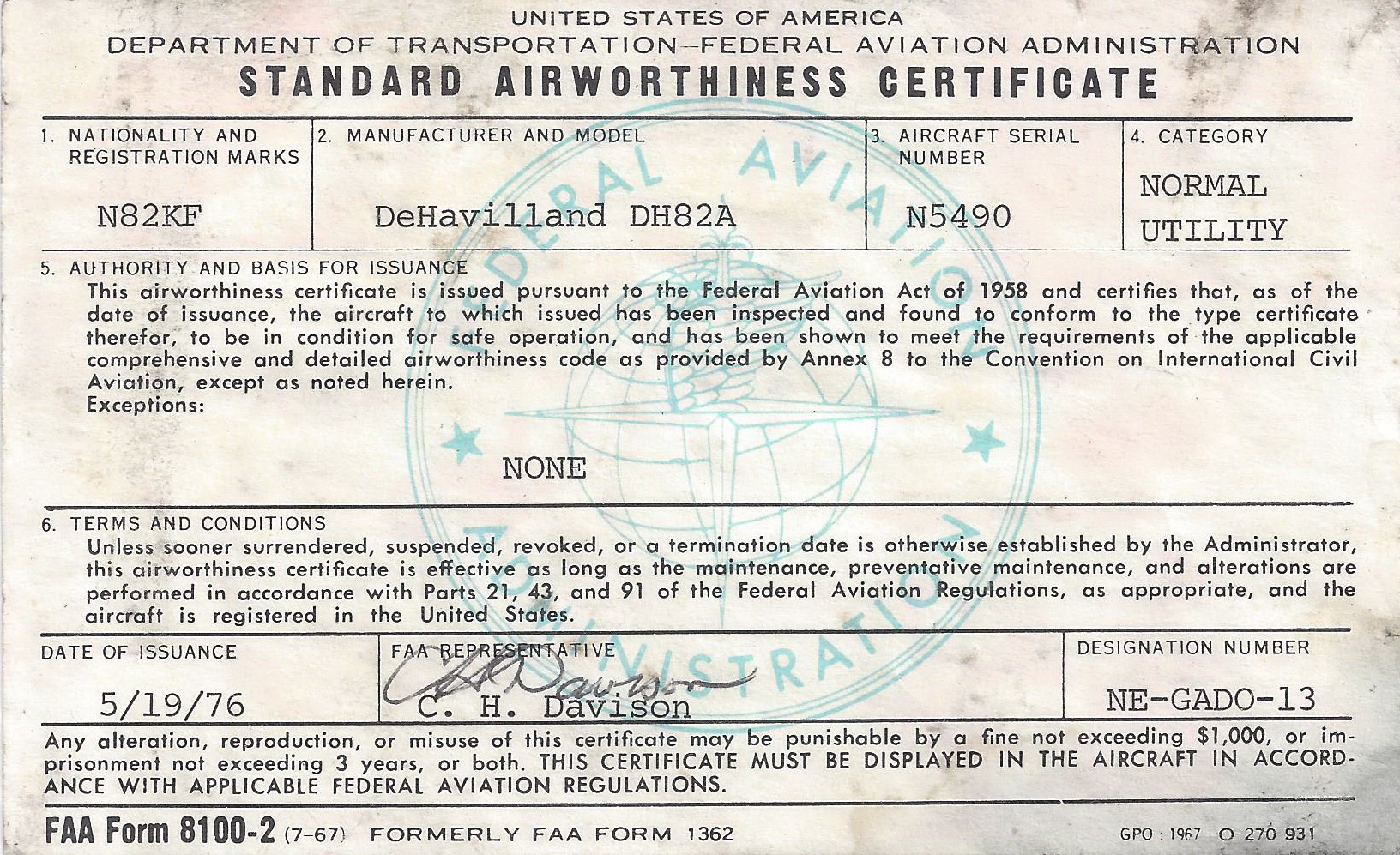
This is the Standard Airworthiness Certificate, dated 19th May 1976.
Captain Geert Frank died in 2011, aged 79. The following is his obituary:

Geert E. Frank, 79, died Tuesday, Sept. 27, 2011, at his home in Kensington.
He was born Oct. 30, 1931, in Amsterdam, Netherlands, the son of the late Evert A. and Elize (Walraven) Frank. Born and raised in Holland, he was a graduate of Saint Ignatius College.
As a child in Holland, he
worked with the Dutch underground in World War II. He was captured
and survived internment in a German labour camp
as a child in occupied Soviet
territory. Years later he was honored with a Soviet medal for his
actions at the end of World War II which saved Russian soldiers as they
returned home.
He was a resident of Kensington for 50 years, where he maintained a landing strip and hangar for his aircraft.
He is survived by his wife of 45 years, Leslie; his brother, Eddie; his children, Doug, Cassie and Tiger and wife Donna; and his grandsons Noah, Chase and Dominick.
He served in the Royal Dutch
Air Force before immigrating to America in 1952. He was a Warrant
officer in the U.S. Army, flying helicopters while stationed in Hawaii.
He became a U.S. citizen
in 1954. Upon leaving the Army in 1957, he was hired by then-Northeast
Airlines as a pilot.
Northeast merged with Delta
Airlines and he flew as a Delta pilot for more than 34 years before retiring.
In his early years with Delta, he volunteered as a pilot for reconnaissance missions on the U2 spy plane.
A lifelong pilot and flying
enthusiast, he imported and restored rare World War II aircraft and motorcycles
at his business, Kensington Aircraft Ltd., based out of Plum Island in
the 1970s.
He was a well-respected
expert in the restoration of the British trainer Tiger Moth.
He worked with many people
on projects to import aircraft, including Hugh Downs, Richard Bach and
Cliff Robertson.
N-5490 was restored by Geert Frank and sold to Kenneth G. French (hence the N82KF registration) of Manchester, Massachusetts in 1976.
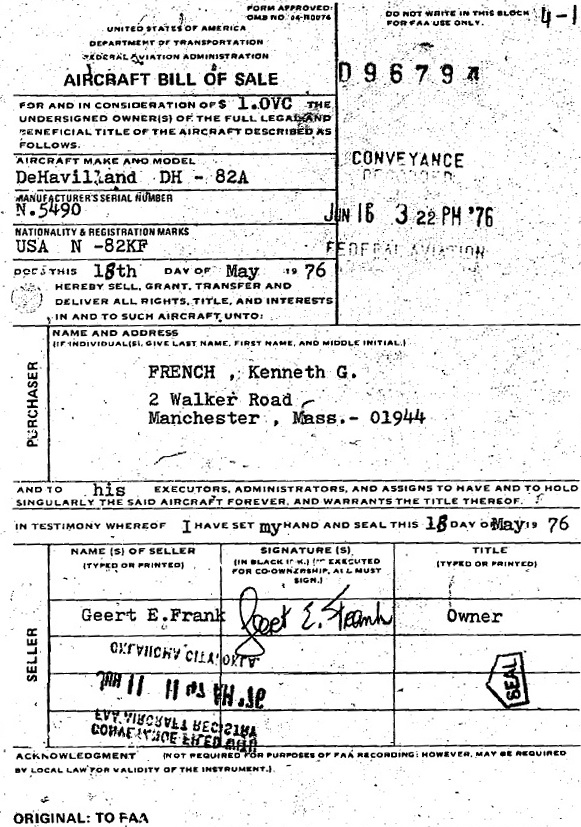
This is the Bill of Sale from Geert Frank to Ken French, dated 18th May 1976.
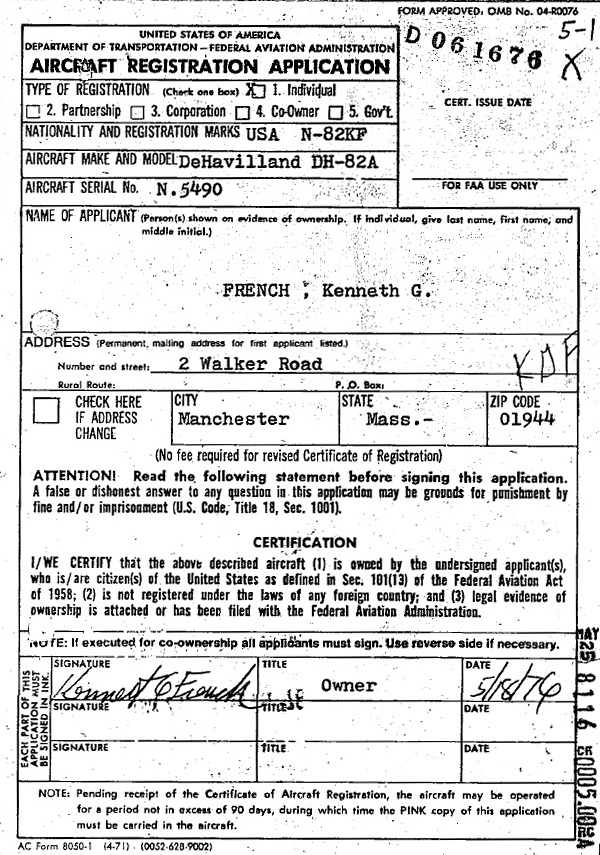
This is the application for FAA registration submitted by Ken Freench, dated 8th May 1976.
Ken kept the Tiger at Plum
Island. However, shortly after this, there was a massive winter storm
combined with a high tide
that inundated Plum Island
airport which is only 11 ft AMSL. The flood was the biggest storm
in memory at Plum Island and shut down
the whole area for three
days. When Ken finally got to the airport, the sea water had receded
but there was a high water mark
about chest height on the
aircraft.
Ken's insurance company wrote
the aircraft off, but once it had dried out, the insurance company sent
airline pilot John Barron to fly it out
to Kansas City on a windy
day - 4th October 1978. Ken warned him about the Tiger, but he replied,
“OK – we'll handle it.”
He got as far as Fitchburg
in west Massachusetts before getting cold and decided to land, and promptly
ground-looped it!
So it stayed there for a
while. It eventually arrived in Kansas City and into the care of
Ron Howes of salvage company White Industries.
Ron contacted Hal Kading
who ran Southwest Aviation, an FBO in Las Cruces, New Mexico. He
also knew that Hal
was interested in old and
interesting aircraft, and so he called him and he acquired N-5490.
Hal then ferried the Tiger
on to Las Cruces along with two Supercubs that he had bought – one in Montana,
the other in Indiana.
They had to keep stopping
because one of the Supercubs used more oil than fuel – 64 quarts on the
trip!
N-5490 finally arrived in
Las Cruces on 27th May 1978 after 32.7 flying hours from Plum Island.
In Las Cruces, the Tiger
was found to be in an undamaged condition so was deemed not to require
a rebuild.
It was claimed that the
flood waters had only submerged the tailwheel!
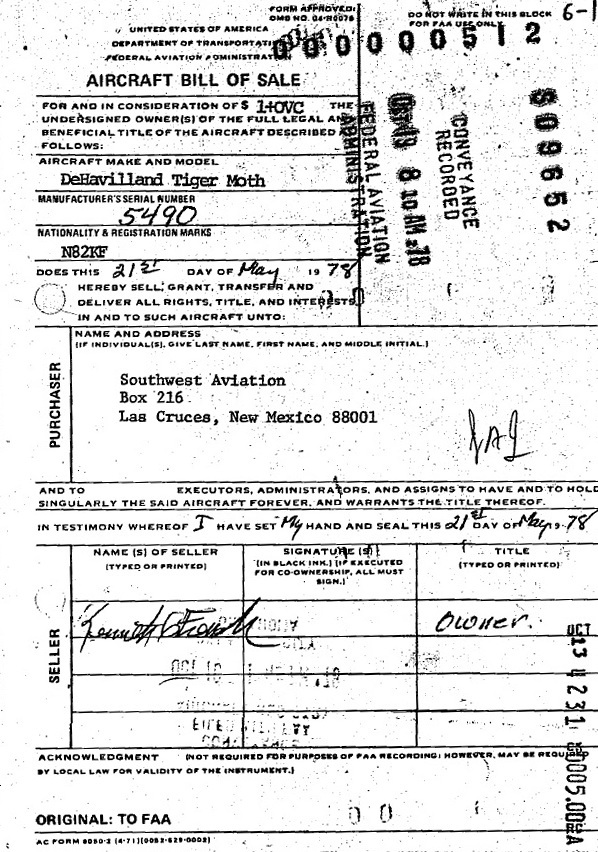
This is the Bill of Sale from Ken French to Soutwest Aviation, dated 21st May 1978.
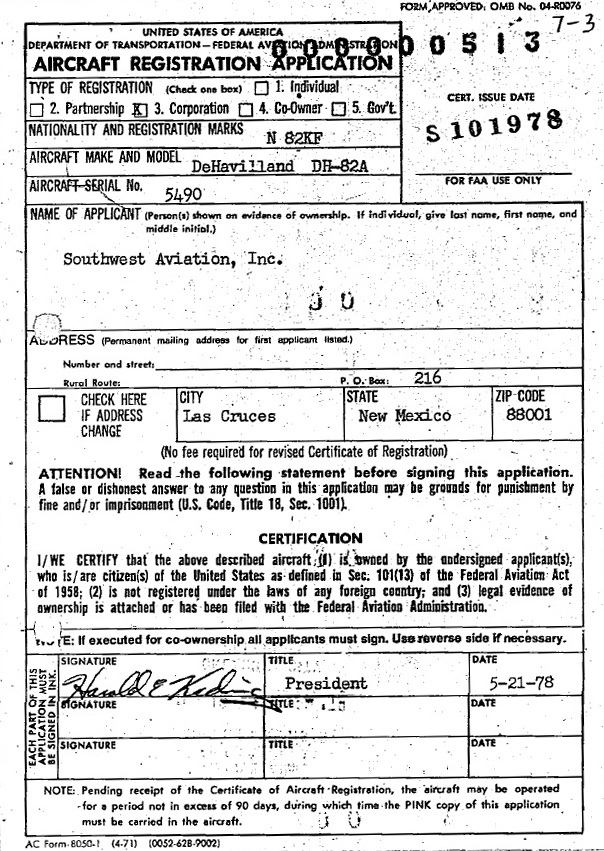
This is the application for FAA registration submitted by Hal Kading, dated 21st May 1978.
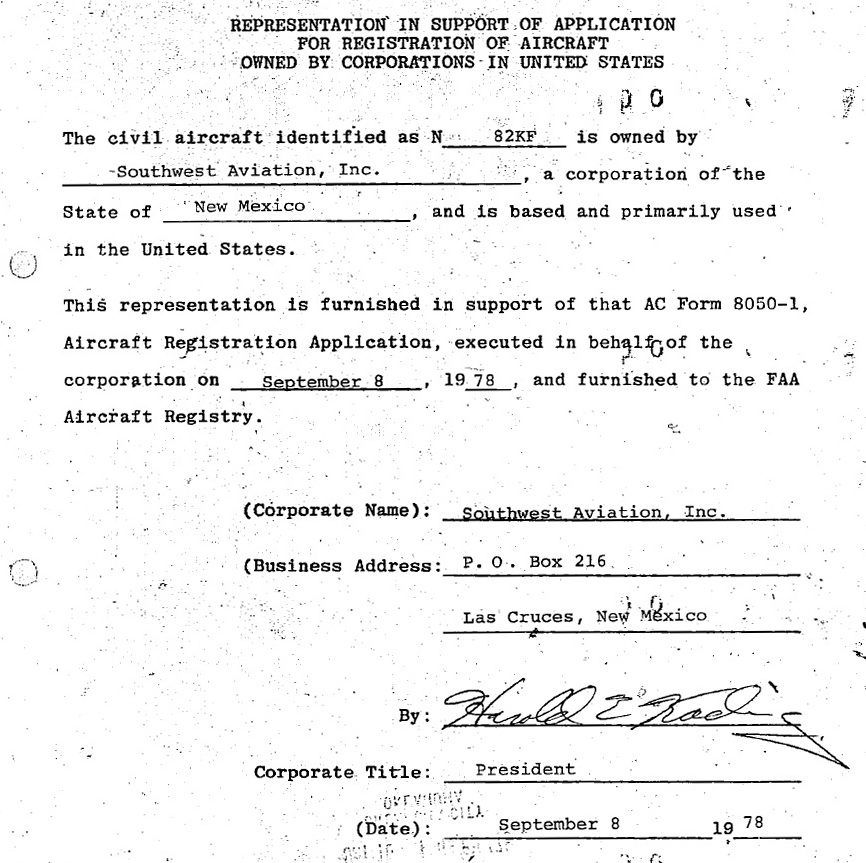
This is a representation in support of the application for FAA registeation submitted by Hal Kading, dated 8th September 1978.
Hal sold the Tiger in January
1979 to Lyle E. Whitmer of Fairbanks, Alaska. So N-5490 was off again
on another long-distance trip.
Lyle and his friend Jerry
Chisolm took two weeks and 52 flying hours to bring the Tiger home to Fairbanks,
so 84.7 hours flying
time from Plum Island, Massachusetts to Fairbanks, Alaska.
The longest leg to Fairbanks
was 1 hour 55 minutes, altitudes were to 10,000 ft, temperatures +90 degrees
F to +25 degrees F.
Maintenance required on
arrival - one sparking plug!
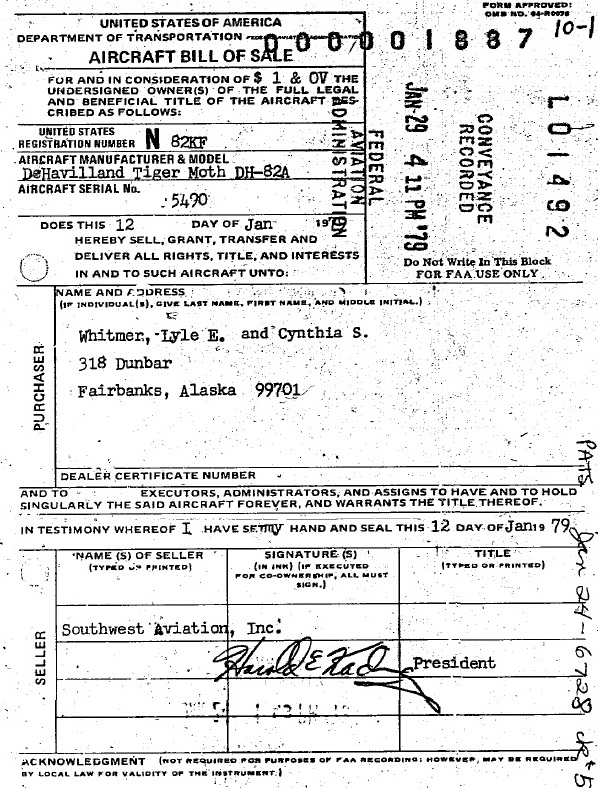
This is the Bill of Sale from Soutwest Aviation to Lyle Whitmer, dated 12th January 1979.

This is the application for FAA registration submitted by Lyle and Cynthia Whitmer.
The Tiger became the flagship
of the local Fairbanks flying club, known as 'The Flying Machine'.
Other pilots who flew it
at the time were Louis Knapp, Dave Fagre and Joe Hawkins
who is now an engineering
professor at the University of Fairbanks.
Conditions in Fairbanks
were rough. One day in June 1979, while Lyle was working on the aircraft
outside,
a windstorm came from nowhere
and blew the aircraft into an adjacent aircraft tug and broke the propeller.
The front starboard interplane
strut and one of the streamline wires also had to be replaced.
July 1983 - Jerry Chisolm
landing N82KF back on the gravel strip at Fairbanks after a trip to McGrath
(320 miles southwest of
Fairbanks) for the Eielson Air Race. Two return trips were made over
the weekend of 22nd/23rd July.
The Eielson Air Races commemorated
Alaska aviation pioneer Ben Eielson who flew the first Air Mail in Alaska
over the same route
from Fairbanks to McGrath
in 1924 using a DH4. Prior to this, mail had been delivered by dog
sled, as seen in the photo below.
The caption reads: 'Alaska's Mail Service. Aviator Eielson with Alaska's first Air Mail service Fairbanks - McGrath 320 miles February 21st 1924.
The Eielson Air Race weekend
was the last time that the Tiger would fly for some time. It was
given a fresh annual on 12th August 1986
before being sold to Dave
Traversi and Bill Graham of Petaluma, California in September.

This is the Bill of Sale from Soutwest Aviation to Lyle Whitmer, dated 22nd July 1986.
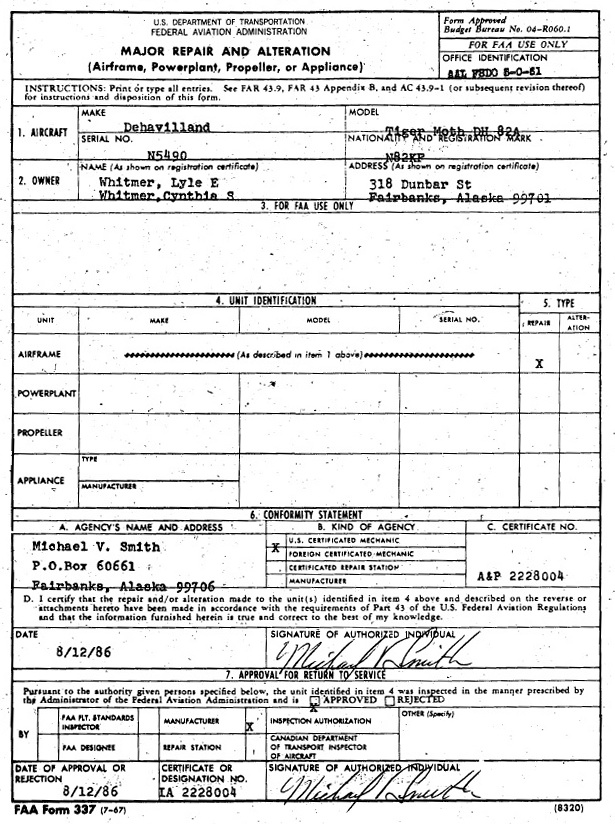
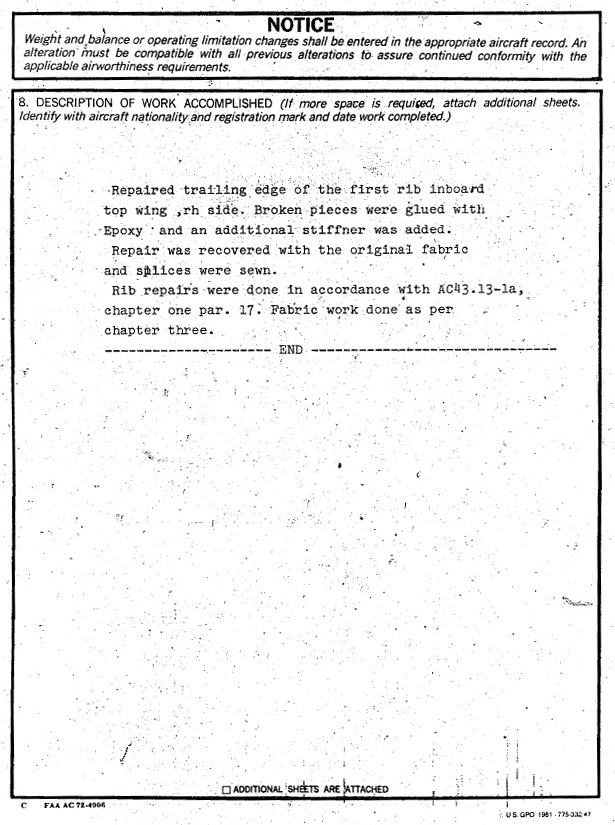
A Major Repair and Alteration form, dated the date of sale, 12th August 1986, detailing repairs to a rib in one of the top wings.

This is the application for FAA registration submitted by Dave Traversi and Bill Graham, dated 22nd July 1986.
So N-5490 was off on another
epic journey from Fairbanks to Petaluma Sky Ranch where Bill was the airport
manager.
It was registered to David
C Traversi in November 1986.
The report in the Yukon News
of N82KF's ferry flight from Fairbanks, Alaska to Petaluma, California.
Jeremy Ainsworth was the English pilot
mentioned in the report.
At that time, Dave nearly lost his fingers in a prop start incident with
the Tiger and decided to fly home by airliner,
Mark Audie taking his seat
in the Tiger. The long trip down, some 3,300 miles, was full of tales
and was documented by various
local papers such as the
one below which was published in the Register-Guard, Eugene, Oregon, Thursday
October 9th 1986.
(However, some of the 'facts'
in this report are clearly in error!)
They flew down the Alcan
(the Alaska Canada) highway which is 1,523 miles long and
does not have many gas stops.
The Tiger could not hold enough fuel to get from airport to airport,
so sometimes they landed
on the dirt road with ice on it and pulled into the gas pump to fuel and
eat. It was quite the sight,
so all passing traffic stopped
to look and the lodge owners kept feeding them to keep the Moth at the
pump.
Moth drawn by fuel, drivers
drawn by Moth!
It was here that I had my
first encounter with N82KF. At that time, as a young RAF Engineering
Officer, I was making frequent trips to
San Francisco in support
of the Skynet IV military satellites that were to be launched by the Space
Shuttle. I spent my weekends staying with Bill
and flying around Petaluma
in a variety of classic types. On arriving for one visit, Bill excitedly
told me that he was about to take delivery of the Tiger.
It was Bill who gave me
the above clipping from the Yukon Times.
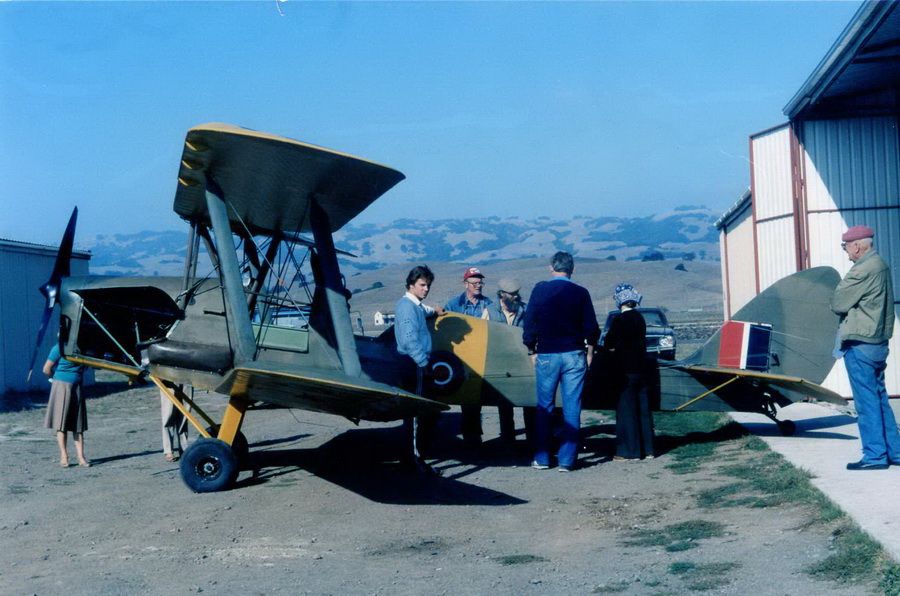
Arrival day at Petaluma Skyranch. The bearded gent is the ferry pilot Jeremy Ainsworth and the chap in the red baseball cap is Bill Graham. (Gracefoto)
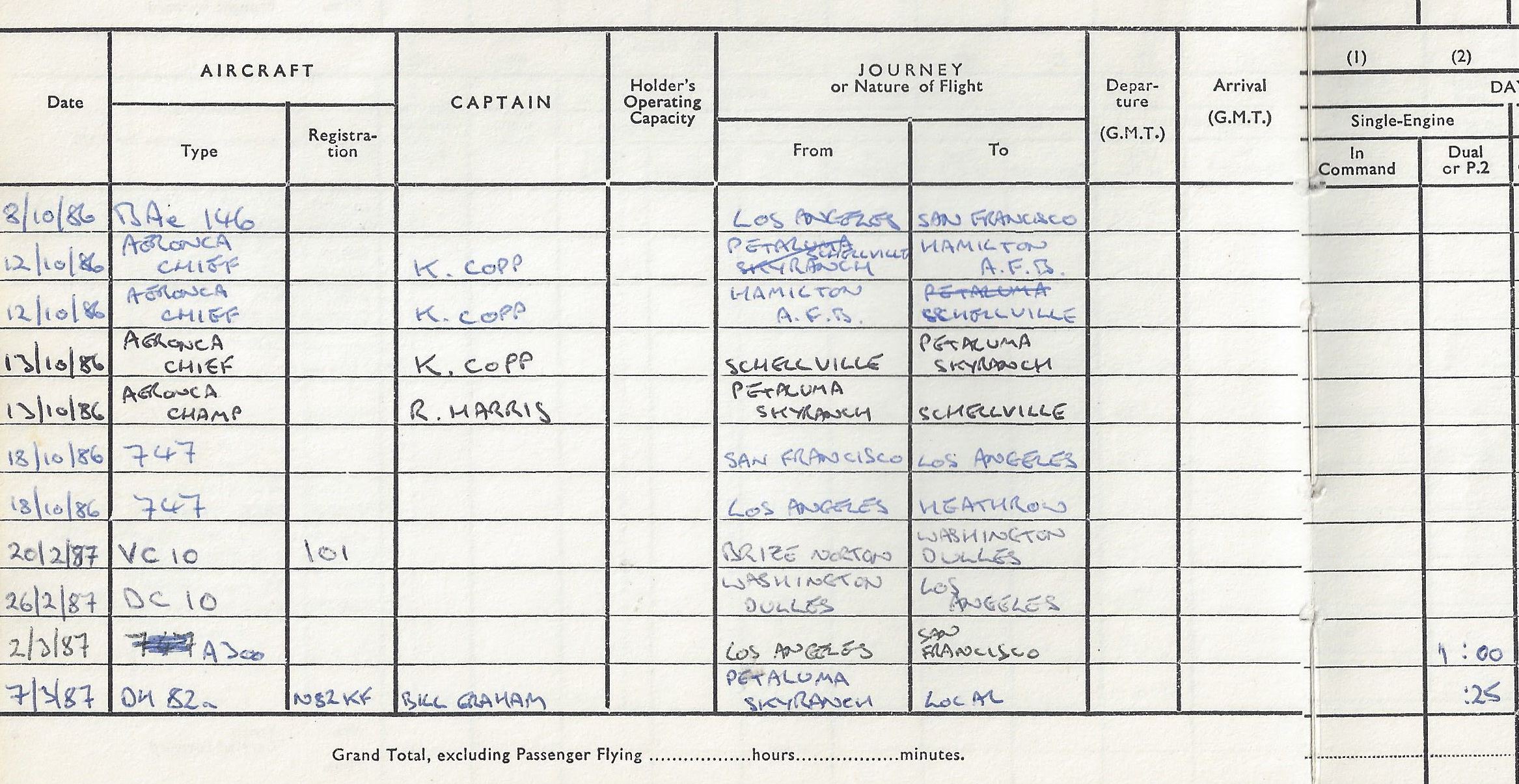
A page from the end of my
logbook, where I used to record my various passenger flights. The
bottom line shows that I flew N-5490
at Petaluma Skyranch with
Bill Graham on Saturday 7th March 1987.
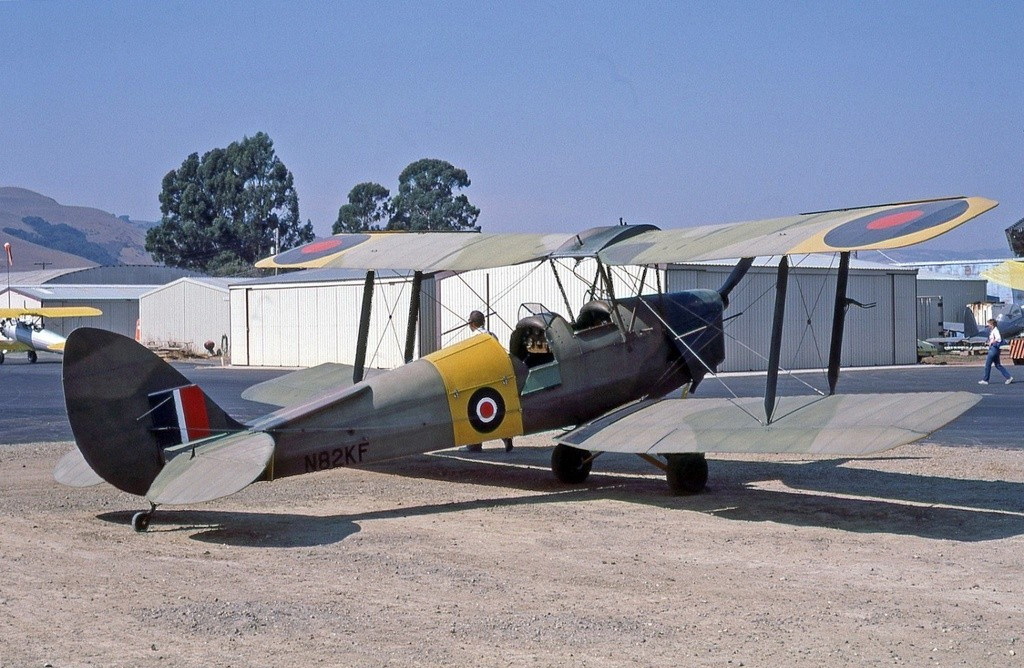
N82KF at Schellville in 1987. (Mike Ody collection via George Trussell)
For a while Bill and Dave
had a third partner who was prone to put the Tiger through its paces ("everywhichwaybutup"),
though they
had decided to forego that
excitement. One day a nearby farmer came driving into the airport
to deliver a front seat cushion
that had rained from above.
The first person he met was Bill who was also the airport manager.
Oops!
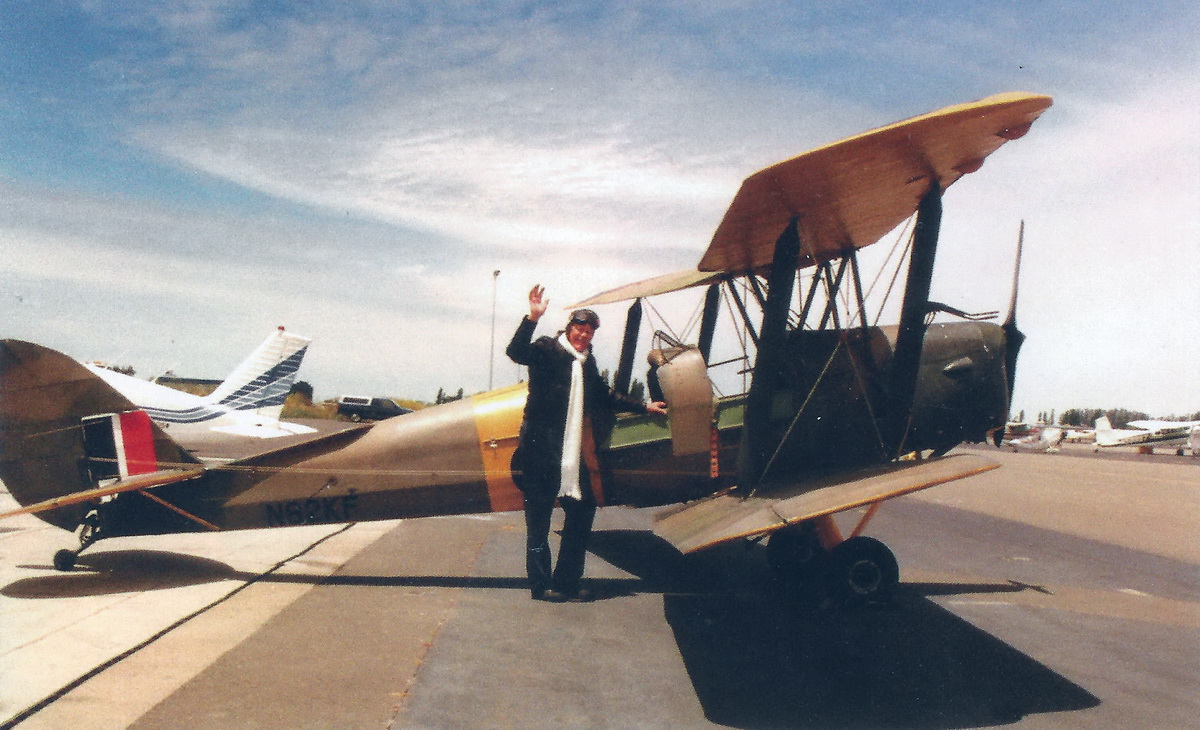
The appropriately-dressed Bill Graham at Petaluma with N82KF, probably in the late eighties. (From 'The Moth' magazine no. 184)
N-5490 was annualed on 1st
June 1990, but on 24th August, N82KF was badly damaged in a landing accident
at Petaluma
while Dave Traversi was
in command. Approaching runway 29, Dave flipped the Tiger on its
back on touchdown
while giving his 80 year
old mother a birthday flight! Fortunately, there were no serious
injuries - except for the poor old Tiger.
The NTSB accident report.
At the time of the accident, N-5490 had flown 800.9 hours since the Plum
Island rebuild in 1976.
At that time, when the aircraft
was imported from France, the hours were 3029:31, so the total time at
this point was 3,830.5 hours.

This is the FAA triennial aircraft registration report for N82KF, dated 25th November 1992.
The old Tiger was rebuilt
again over a period of several years under the watchful eye of Bill Decker.
The starboard lower wing
was completely rebuilt with
new spars, the tail feathers were replaced, the port fuselage sideframe
repaired and much more.
In the Moth magazine no.
89 of 1995 Bill Graham reported: "The status of N82KF is as follows:
all the woodwork is done:
wings are being recovered;
tail feathers are all new and are being recovered. The fuel tank
has been repaired.
We have a new nose cowling
(from England); fuselage has been repaired but does not need recovering;
the landing gear
has been mended and new
tires mounted. We need a new propeller and a cowling to be straightened
out along with some
baffle repairs, then painting,
rigging and assembly. We did most of the work ourselves except for
covering the wings and
fixing the fuel tank.
Managing the airport (200 resident aeroplanes, 59 hangars and building
35 more) is very demanding
so I don't have large blocks
of time available, but we are getting there. In between times, I
have been working on my old
Aeronca Champ. It
needs an engine overhaul. Our Tiger Moth will not be an award winner
like Tom's [Tom Kewin] or Ken's [Ken Copp]
which are exquisite in every
detail. It will be more commensurate with an EFTS setting."
In the Moth magazine no.
90 of 1995 Bill Graham reported that "thanks to help rendered by Tom Kewin,
Ken Copp and
friends, the restoration
of N82KF is well on: wings all repaired, one totally rebuilt with new spars,
etc., all new tail unit,
fuselage repaired, wings
being recovered. The reports ends in a good housekeeping manner:
Repair cowling. Buy
a new prop!"
In the Moth magazine No.
94 of 1995, it was reported that "Tiger Moth N82KF should be back in the
air this summer after some ground level
interference a few years
ago. Parts have been collected from around the USA. When one
of the co-owners is the manager of the
municipal airfield at Petaluma,
there seems little doubt that the aircraft will be afforded some flight
privilege."
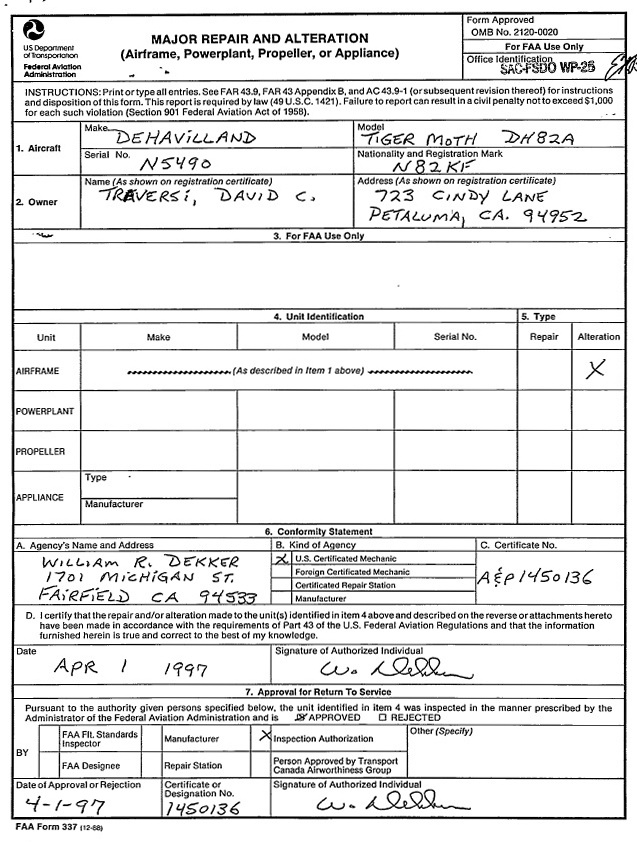
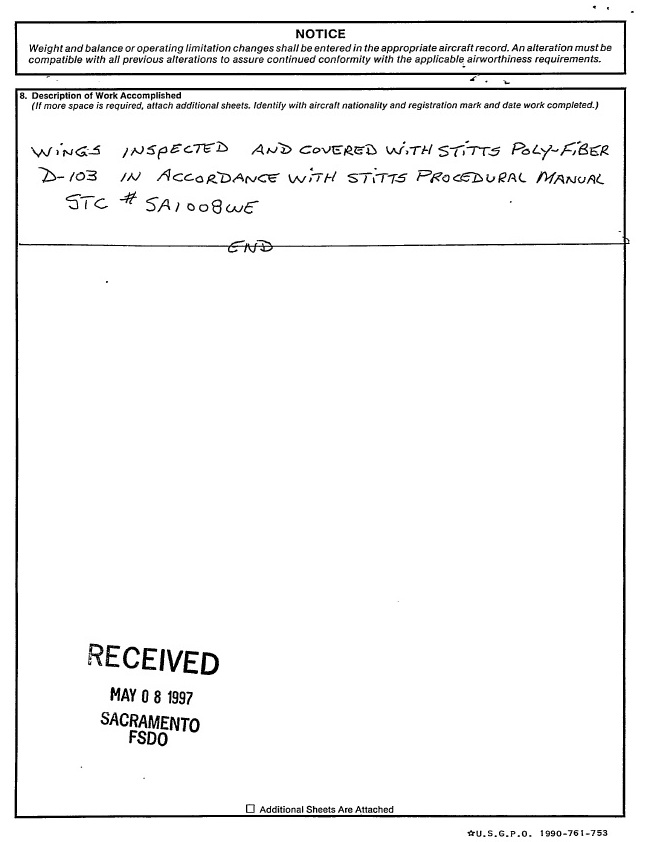
The FAA Major Repair and
Alteration form covering the repairs subsequest to the acident, dated 1st
April 1997.
(Note the description of
work accomplished - "Wings inspected and covered"!)
Bill passed away in 1997 and N-5490 was subsequently offered for sale in the Moth Club's Paper Tiger newsletter.

It was subsequently offered
via Ron Howes, who had originally acquired
it from Ken French after
the Plum Island storm. The advertisement, dated 2nd February 1999
read:
1938 DeHavilland DH82A Tiger
Moth N82KF
AirFrame: Built by DeHavilland
for the Royal Air Force (RAF) in 1938
Hours: Total Time 3,824
Hrs, 804.9 SMOH
Motor: Gipsy Major 1C, 145
hp, 804. 9 SMOH
Propeller Sensenich, Pitch
60, 4.0 SMOH
4 Hrs since Complete Restoration
(Fabric, Spars, Ribs, Braces, Etc.) of Wings, Empenage, Rudder, Rudder
Post, Stabilizer, Elevators. Finished in 1998
4 Hrs on New Tires, Brake
Overhaul, Landing Gear Re-Bush and Hardware
Fresh Annual with Compressions
in the 70's
The Aircraft is Finished
in Authentic RAF Colors with Appropriate Rondels
Important Points for Daily
Use are:
Steerable Tailwheel
Hydraulic Brakes
Battery and Starter System
Spin Strakes
Slats, Manual Lockable
Baggage Compartment
4-Point Seatbelts
Ron Howes
Global Air
Princeton, Minnesota
It was acquired in May 1999 by retired United Airlines Flight Engineer Keith Woodmansee of Tacoma, Washington.
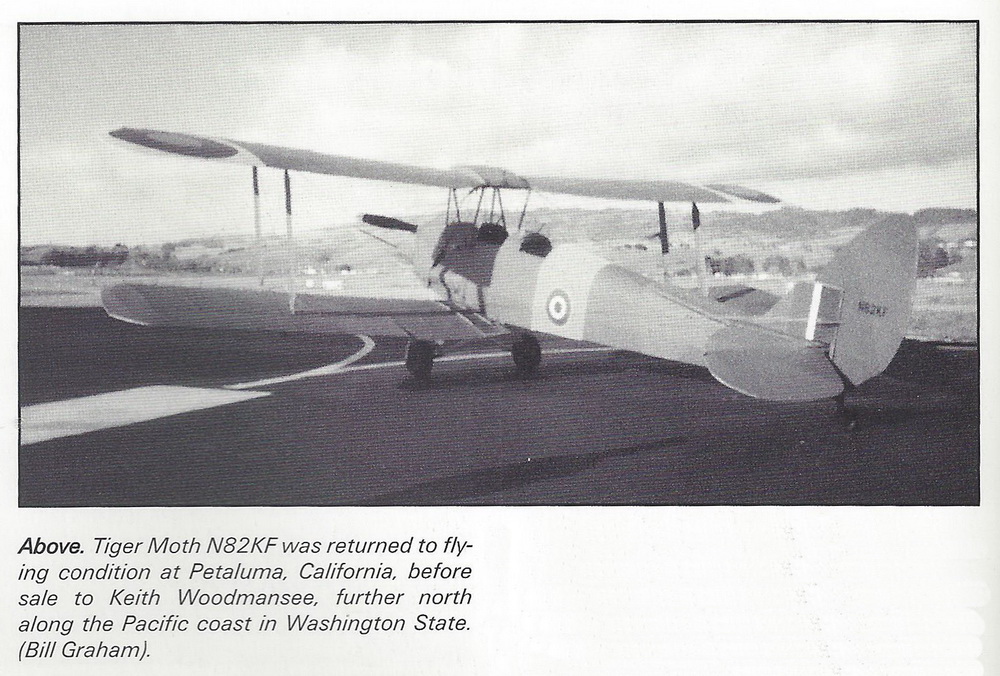
The report of the sale in the DH Moth Club's magazine no. 110 of 2000, and below is the accompanying letter from Bill Graham.

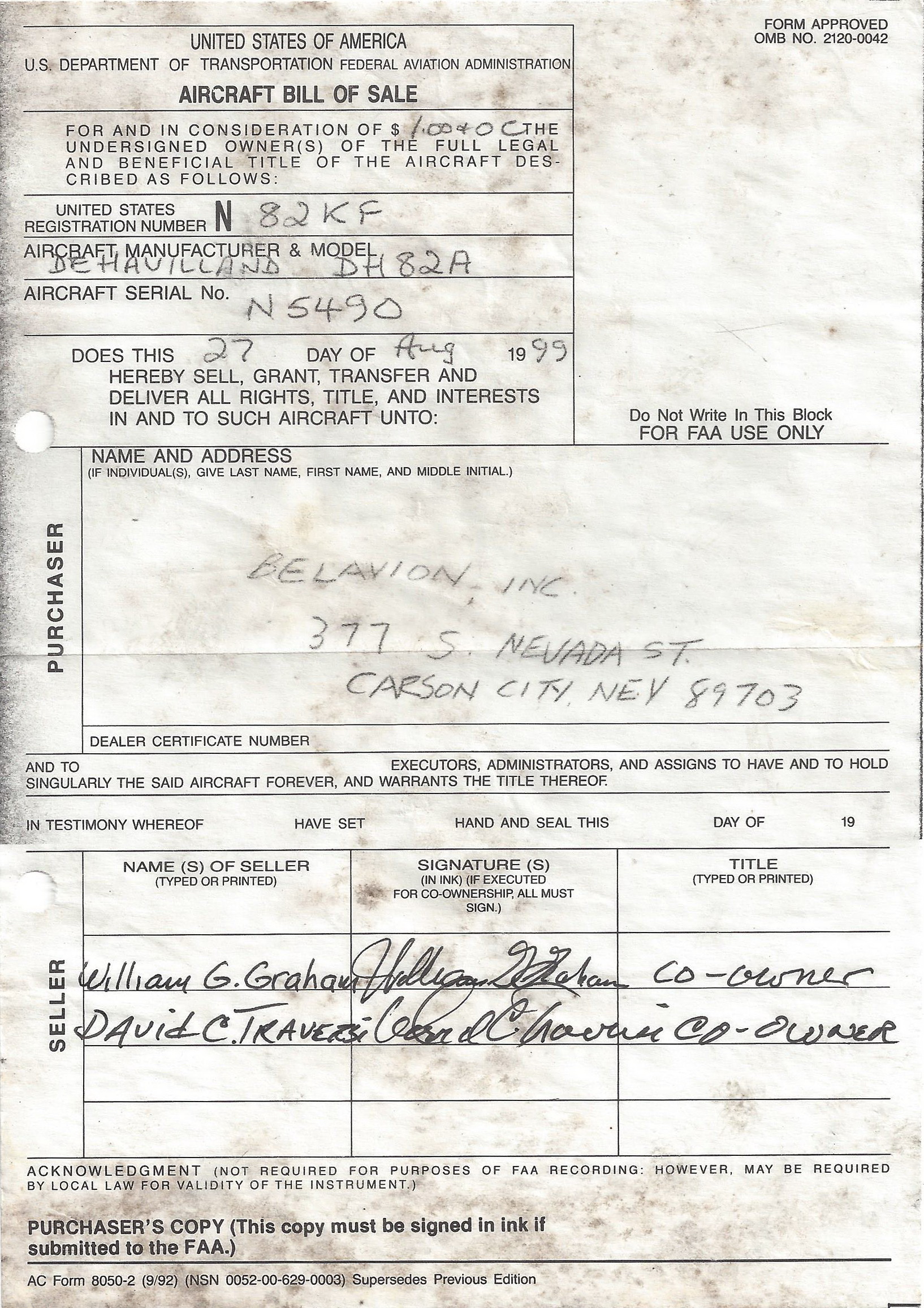
Here is the Bill of Sale
recording the transfer of custodianship of N-5490 from co-owners Bill Graham
and Dave Traversi to Belavion Inc., the company owned by
Keith Woodmansee.
As is common with aircraft sales, the sale price is recorded as "$1-00
&OC", meaning one Dollar and other considerations.

This is the application for FAA registration submitted by Keith Woodmansee.
The Tiger was ferried to Harvey Field, about 30 miles northeast of Seattle.
It was Jeremy Ainsworth,
who had ferried the Tiger from Fairbanks that flew the Tiger up to Harvey
Field.
He had given Keith 6-8 hours
instruction but concluded that he wasn’t quite up to the ferry flight,
so Jeremy flew it up with
his girlfriend Christine, who was an airline pilot, in the front cockpit.
They had no means of communicating,
so agreed that each would
shake the stick if they wanted the other to take control. On the
way up, the luggage locker
behind the rear cockpit
came unlatched and Jeremy was worried that it would tear itself off if
left flapping in the slipstream.
So he shook the stick and
Christine took over. Jeremy then undid his seat harness so that he
could reach around
to try to secure the luggage
locker latches. Unfortunately, as he turned, he nudged the
stick with his knee and Christine
thought he wanted control
back, so let go of the stick, whereupon the Tiger rolled to the right and
Jeremy was only just able
to hang on and not be propelled
out of the aircraft, thus averting what would have been a freak tragedy.
At Harvey Field, Keith continued
his conversion onto type. But this did not go well. Keith struggled
to master the Tiger,
which resulted in a couple
accidents after which various repairs were made locally.
On one occasion, when approaching
too low, the throttle was opened too late, and the longsuffering old Tiger
was flown through
the airport perimeter fence
at full throttle!
Local Boweing engineer and A&P was in the front seat on thsi flight. He reports:
"I had just fixed an inlet
manifold leak for Keith and we went flying together. On one approach,
Keith was coming in much too low.
I told him over the intercom
to add power, but nothing happened. Eventually I opened the throttle
myself, but it was too late. The Tiger stuck the airfield boundary
fence,
the top rail of which hit
the propeller just below the hub. This shattered the propeller instantly,
as the engine was now at full throttle!
This was actually very lucky
because, had we been a foot or two higher, the landing gear would have
clipped the fence and we would have flipped over."
Indeed. That could have been disastrous and also meant the end of this long-suffering old warhorse.
Here is all that was left of that propeller:
Dave had tried repeatedly to check Keith out on his Tiger, but Keith sufered from an almostr complete lack of depth perception.
At one point, Dave placed his high visibility jacket half way down the strip to give Ketih a touchdown aiming point, but to no avail.
On another occasion, the
Tiger had been put down in a field near Monroe
on a hot summer day.
On taking off, the Tiger lifted - and then sank back onto the grass, only
to run into a hay bale. More repairs.
The Tiger's logbook shows
repairs to the leading edges of both lower wings being signed off by Dave
Riffle on 15th May 2003.
Dave also signed off more
repairs to the starboard lower wing on 27th October 2006.
That was to be the final
logbook entry - to this day. At this point the total hours are recoded
in the aircraft's logbook as 3,977.3,
so it had flown 146.8 hours
in the ownership of Keith Woodmansee.
Eventually, Keith lost his
PPL medical due to his eyesight problems and N-5490 languished in its open-fronted
T hangar at Harvey Field for the next five years.
My family and I moved from
the UK to Grand Rapids, Michigan in 1999 and then moved to the Seattle
area in 2008
and bought a house about
15 miles from Harvey Field. I drove past Harvey on various occasions
and the old Tiger was easily visible
as its T hangar faced the
road. On one occasion, on pure impulse, I decided to stop and take
a closer look. Imagine my surprise when I found that this
was Bill Graham's old Tiger!
I made enquiries, discovered that the aircraft had not flown for many years,
and eventually tracked down the owner.
I contacted Keith and a
deal was struck in August 2011.
Keith was a true gentleman
with a wealth of flying stories from a long and varied career and I very
much enjoyed several trips to his home.
N-5490 as found - forlorn and covered in starling droppings.
The starlings' home for several summers!
Shortly after, the Tiger was de-rigged and removed for a complete restoration to its original 1938 specification and markings.
Home at last - and in the good company of some English pre-war cars. Now the serious restoration work can commence.
Sadly, Keith Woodmansee passed away on 5th March 2012. His obituary read:
Willard Keith Woodmansee,
87, also known as "Woody", passed away peacefully in Tacoma, Washington
on March 5, 2012.
Keith had a life-long passion
for sailing, flying, and traveling the globe. Keith grew up in Utah
and Virginia, and took his
first flying lessons at
the age of 15. In WWII, he served with the U.S. Maritime Service
as radio officer and purser in the
Atlantic and Pacific Oceans.
His flying career spanned over 45 years, starting with the Boeing 314 "Flying
Boats"
to destinations in Europe
and the Caribbean. In the early years of his career in commercial
aviation,
Keith flew for American
International, World Airways, and the Flying Tigers. He first joined
Pan Am American World Airways
as flight radio officer
in 1946 and was later rehired by PAA as flight engineer. From the
1940's to the 1990's, he flew
numerous aircraft, including
L-Constellation (the “Connie”), DC 3-10, Boeing 377 Stratocruiser, B 707,
727 and 747.
Keith was San Francisco
based during most of his time with Pan Am and United Airlines, aside from
a 3-year stint in Berlin
in the early '60's, during
which he and his growing family lived in Strasbourg, France.
In early 1994, then residing
in Seattle, Washington, Keith retired from PAA/UA. Nevertheless,
he continued to pursue
new adventures in flying
which included paragliding in the Cascade Mountains,
taking floatplane lessons
in Florida, and flying his de Havilland Tiger Moth out of Harvey Field,
near Seattle.
Keith is survived by his
first wife, Teresa Woodmansee; his three daughters, Ann Woodmansee, Helen
Hall, and Suzy Woodmansee;
his two brothers, Charles
and Glen; and his wife Roberta Woodmansee.
A celebration of Keith's
life was held at his home in Browns Point/Tacoma, Washington on March 9,
2012.
(What Keith's obituary does
not mention is his part in the dramatic Bermuda Sky Queen incident in October
1947.
Keith was the radio operator
aboard Boeing this Model 314 NC-18612, operated by American International
Airways
that landed in mid-Atlantic
in mountainous seas on 14th October 1947 near the United States Coast Guard
weather ship, "Bibb".
Three days later, all 62
passengers and the crew of seven were rescued by the Bibb and the rescue
was heralded
as one of the greatest Atlantic
rescues in history. After the rescue, the aircraft was sunk by gunfire
since it constituted a hazard
to surface vessels. Read the Civil Aviation Board's accident report
here.
The dramatic newsreel film
of the rescue can be viewed here.)
Little did I realise when
I stumbled across N82KF at Harvey Field that I would be able to uncover
so much history, not only
of N-5490, but of the pilots who learned
to fly in her - many of whom
went on to heroic flying
careers in the Battle of Britain and beyond, and many paying
the ultimate sacrifice to
defend the free world. So this rebuild project has become so much
more than just another aircraft restoration.
It has become the means
by which history can be unearthed, collated and preserved in remembrance
of those courageous young men.
N-5490 is currently undergoing
a comprehensive and meticulous restoration to its original 1938 specification
and 20 ERFTS markings.
Once airworthy again in
the not too distant future, N-5490 will become a living, flying memorial
to the brave young airmen
who learned their trade
in her in darker days.
N-5490 over Fairbanks, Alaska
at dusk, with Mount McKinley just visible off the starboard wing.
A world away in so many
ways from pre-war Gravesend in Kent.
Soon she will be flying
on once again, into the future, as a living memorial to the greatest generation.
(Photo: Gary Porter)
Lest We Forget
Follow the restoration of N-5490 here.
Click here to return to the top of the page